

This document is an excerpt from the EUR-Lex website
Document 02008R0798-20190914
Commission Regulation (EC) No 798/2008 of 8 August 2008 laying down a list of third countries, territories, zones or compartments from which poultry and poultry products may be imported into and transit through the Community and the veterinary certification requirements (Text with EEA relevance)Text with EEA relevance
Consolidated text: Commission Regulation (EC) No 798/2008 of 8 August 2008 laying down a list of third countries, territories, zones or compartments from which poultry and poultry products may be imported into and transit through the Community and the veterinary certification requirements (Text with EEA relevance)Text with EEA relevance
Commission Regulation (EC) No 798/2008 of 8 August 2008 laying down a list of third countries, territories, zones or compartments from which poultry and poultry products may be imported into and transit through the Community and the veterinary certification requirements (Text with EEA relevance)Text with EEA relevance
02008R0798 — EN — 14.09.2019 — 040.001
This text is meant purely as a documentation tool and has no legal effect. The Union's institutions do not assume any liability for its contents. The authentic versions of the relevant acts, including their preambles, are those published in the Official Journal of the European Union and available in EUR-Lex. Those official texts are directly accessible through the links embedded in this document
|
COMMISSION REGULATION (EC) No 798/2008 of 8 August 2008 laying down a list of third countries, territories, zones or compartments from which poultry and poultry products may be imported into and transit through the Community and the veterinary certification requirements (OJ L 226 23.8.2008, p. 1) |
Amended by:
Corrected by:
COMMISSION REGULATION (EC) No 798/2008
of 8 August 2008
laying down a list of third countries, territories, zones or compartments from which poultry and poultry products may be imported into and transit through the Community and the veterinary certification requirements
(Text with EEA relevance)
CHAPTER I
SUBJECT MATTER, SCOPE AND DEFINITIONS
Article 1
Subject matter and scope
1. This Regulation lays down veterinary certification requirements for imports into and transit, including storage during transit, through the Community of the following commodities (the commodities):
(a) poultry, hatching eggs, day-old chicks and specified pathogen-free eggs;
(b) meat, minced meat and mechanically separated meat of poultry, including ratites and wild game-birds, eggs and egg products.
It lays down a list of third countries, territories, zones or compartments from which the commodities may be imported into the Community.
2. This Regulation shall not apply to poultry for exhibitions, shows or contests.
3. This Regulation shall apply without prejudice to specific certification requirements provided for in Community agreements with third countries.
Article 2
Definitions
For the purposes of this Regulation, the following definitions shall apply:
(1) ‘poultry’ means fowl, s, guinea fowl, ducks, geese, quails, pigeons, pheasants, partridges and ratites (ratitae), reared or kept in captivity for breeding, the production of meat or eggs for consumption, or for restocking supplies of game;
(2) ‘hatching eggs’ means eggs for incubation, laid by poultry;
(3) ‘day-old chicks’ means all poultry less than 72 hours old, not yet fed and muscovy ducks (Cairina moschata) or their crosses, less than 72 hours old whether or not fed;
(4) ‘breeding poultry’ means poultry 72 hours old or more, intended for the production of hatching eggs;
(5) ‘productive poultry’ means poultry 72 hours old or more, reared for:
(a) the production of meat and/or eggs for consumption; or
(b) the restocking of supplies of game;
(6) ‘specified pathogen-free eggs’ means hatching eggs which are derived from ‘chicken flocks free from specified pathogens’, as described in the European Pharmacopoeia ( 1 ), and which are intended solely for diagnostic, research or pharmaceutical use;
(7) ‘meat’ means edible parts of the following animals:
(a) poultry, which, when relating to meat, means farmed birds, including birds that are farmed as domestic animals without being considered as such, with the exception of ratites;
(b) wild game-birds that are hunted for human consumption;
(c) ratites;
(8) ‘mechanically separated meat’ means the product obtained by removing meat from flesh-bearing bones after boning or from poultry carcases, using mechanical means resulting in the loss or modification of the muscle fibre structure;
(9) ‘minced meat’ means de-boned meat that has been minced into fragments and contains less than 1 % salt;
(10) ‘zone’ means a clearly defined part of a third country containing an animal subpopulation with a distinct health status with respect to a specific disease for which the required surveillance, control and biosecurity measures have been applied for the purpose of imports under this Regulation;
(11) ‘compartment’ means one or more poultry establishments in a third country under a common biosecurity management system containing a poultry subpopulation with a distinct health status with respect to a specific disease or diseases for which the required surveillance, control and biosecurity measures have been applied for the purpose of imports under this Regulation;
(12) ‘establishment’ means a facility or part of a facility which occupies a single site and is devoted to one or more of the following activities:
(a) pedigree breeding establishment: an establishment which produces hatching eggs for the production of breeding poultry;
(b) breeding establishment: an establishment which produces hatching eggs for the production of productive poultry;
(c) rearing establishment either:
(i) a breeding poultry-rearing establishment which rears breeding poultry prior to the reproductive stage; or
(ii) a productive poultry-rearing establishment which rears egg-laying productive poultry prior to the laying stage;
(d) keeping of other productive poultry;
(13) ‘hatchery’ means an establishment which incubates and hatches eggs and supplies day-old chicks;
(14) ‘flock’ means all poultry of the same health status kept on the same facilities or in the same enclosure and constituting a single epidemiological unit; as regards housed poultry, this definition includes all birds sharing the same airspace;
(15) ‘avian influenza’ means an infection of poultry caused by any influenza A virus:
(a) of the subtypes H5 or H7;
(b) with an intravenous pathogenicity index (IVPI) in six-week old chickens greater than 1,2; or
(c) causing at least 75 % mortality in four- to 8-week-old chickens infected intravenously;
(16) ‘highly pathogenic avian influenza’ (HPAI) means an infection of poultry caused by:
(a) avian influenza viruses of the subtypes H5 or H7 with genome sequences codifying for multiple basic amino acids at the cleavage site of the haemagglutinin molecule similar to that observed for other HPAI viruses, indicating that the haemagglutinin molecule can be cleaved by a host ubiquitous protease;
(b) avian influenza as defined in point 15(b) and (c);
(17) ‘low pathogenic avian influenza’ (LPAI) means an infection of poultry caused by avian influenza viruses of subtypes H5 or H7 other than HPAI;
(18) ‘Newcastle disease’ means an infection of poultry:
(a) caused by any avian strain of the paramyxovirus 1 with an intracerebral pathogenicity index (ICPI) in day-old chicks greater than 0,7; or
(b) multiple basic amino acids have been demonstrated in the virus (either directly or by deduction) at the C-terminus of the F2 protein and phenylalanine at residue 117, which is the N-terminus of the F1 protein; the term ‘multiple basic amino acids’ refers to at least three arginine or lysine residues between residues 113 and 116; failure to demonstrate the characteristic pattern of amino acid residues as described in this point requires characterisation of the isolated virus by an ICPI test; in this definition, amino acid residues are numbered from the N-terminus of the amino acid sequence deduced from the nucleotide sequence of the F0 gene, 113-116 corresponds to residues -4 to -1 from the cleavage site;
(19) ‘official veterinarian’ means the veterinarian designated by the competent authority;
(20) ‘differentiating infected from vaccinated animal (DIVA) strategy’ means a vaccination strategy which enables a differentiation to be made between vaccinated/infected and vaccinated/non-infected animals through the application of a diagnostic test designed to detect antibodies against the field virus and the use of non-vaccinated sentinel birds.
CHAPTER II
GENERAL CONDITIONS FOR IMPORTS AND TRANSIT
Article 3
Lists of third countries, territories, zones or compartments of origin from which commodities may be imported into and transit through the Community
The commodities shall only be imported into and transit through the Community from the third countries, territories, zones or compartments listed in columns 1 and 3 of the table in Part 1 of Annex I.
Article 4
Veterinary certification
1. Commodities imported into the Community shall be accompanied by a veterinary certificate, as referred to in column 4 of the table in Part 1 of Annex I, for the commodity concerned, completed in accordance with the notes and the model veterinary certificates set out in Part 2 of that Annex (the certificate).
2. A declaration by the master of the ship, as set out in Annex II, shall be attached to veterinary certificates for imports of poultry and day-old chicks, where the transport of those commodities includes transport by ship, even for part of the journey.
3. Poultry, hatching eggs and day-old chicks transiting through the Community shall be accompanied by:
(a) a veterinary certificate as referred to in paragraph 1 which shall bear the words ‘for transit through the EC’, and
(b) a certificate required by the third country of destination.
4. Specified pathogen-free eggs, meat, minced meat and mechanically separated meat of poultry, ratites and wild game-birds, eggs and egg products transiting through the Community shall be accompanied by a certificate drawn up in accordance with the model certificate set out in Annex XI and complying with the conditions set out therein.
5. For the purposes of this Regulation, transit may include storage during transit in accordance with Articles 12 and 13 of Directive 97/78/EC.
6. Electronic certification and other agreed systems harmonised at Community level may be used.
Article 5
Conditions for imports and transit
1. Commodities imported into and transiting through the Union shall comply with the following:
(a) the conditions laid down in Articles 6 and 7 and in Chapter III;
(b) the additional guarantees, as specified in column 5 of the table in Part 1 of Annex I;
(c) the specific conditions set out in column 6, and where appropriate, the closing dates set out in column 6A and the opening dates set out in column 6B, of the table in Part 1 of Annex I;
(d) the conditions in relation to the approval of a salmonella control programme and related restrictions which shall only apply when indicated in the appropriate column of the table in Part 1 of Annex I;
(e) the animal health additional guarantees, where required by the Member State of destination and referred to in the certificate.
2. The following conditions set out in paragraph 1 shall not apply to single consignments of less than 20 units of poultry other than ratites, hatching eggs and day-old chicks thereof:
(a) point (b);
(b) point (d) when destined for primary production of poultry for private domestic use or leading to the direct supply, by the producer, of small quantities of primary products as referred to in Article 1(3) of Regulation (EC) No 2160/2003.
Article 6
Examination, sampling and testing procedures
Where examination, sampling and testing for avian influenza, Mycoplasma, Newcastle disease, Salmonella, and other pathogens of animal or public health significance is required for imports of commodities into the Community in accordance with the certificates, such commodities shall only be imported into the Community where those examinations, sampling and testing have been carried out by the competent authority of the third country concerned or where appropriate by the competent authority of the Member State of destination in accordance with Annex III.
Article 7
Disease reporting requirements
Commodities shall only be imported into the Community from third countries, territories, zones or compartments, where the third country concerned:
(a) informs the Commission of the disease situation within 24 hours of confirmation of any initial outbreaks of LPAI, HPAI or Newcastle disease;
(b) submits virus isolates from initial outbreaks of HPAI and Newcastle disease, without undue delay to the Community reference laboratory for avian influenza and Newcastle disease ( 2 ); such virus isolates shall not be required for imports of eggs, egg products and specified pathogen-free eggs from third countries, territories, zones or compartments from which the import of such commodities into the Community is authorised;
(c) submits to the Commission regular updates on the disease situation.
CHAPTER III
ANIMAL HEALTH STATUS OF THIRD COUNTRIES, TERRITORIES, ZONES OR COMPARTMENTS OF ORIGIN WITH REGARD TO AVIAN INFLUENZA AND NEWCASTLE DISEASE
Article 8
Avian influenza free third countries, territories, zones or compartments
1. For the purposes of this Regulation, a third country, territory, zone or compartment from which commodities are imported into the Community shall be considered as free from avian influenza where:
(a) avian influenza has not been present in the third country, territory, zone or compartment for a period of at least 12 months preceding the certification by the official veterinarian;
(b) an avian influenza surveillance programme, in accordance with Article 10 has been carried out during a period of at least six months preceding the certification referred to in point (a) of this paragraph where required in the certificate.
2. Where an outbreak of avian influenza occurs in a third country, territory, zone or compartment previously free of that disease, as referred to in paragraph 1, that third country, territory, zone or compartment shall again be considered as free from avian influenza provided the following conditions have been met:
(a) in the case of HPAI, a stamping out policy has been implemented to control the disease;
(b) in the case of LPAI, either a stamping out policy has been implemented or the poultry have been slaughtered to control the disease;
(c) adequate cleansing and disinfection has been carried out on all previously infected establishments;
(d) avian influenza surveillance has been carried out in accordance with Part II of Annex IV during a three-month period following completion of the cleansing and disinfection referred to in point (c) of this paragraph with negative results.
Article 9
HPAI free third countries, territories, zones and compartments
1. For the purposes of this Regulation, a third country, territory, zone or compartment from which commodities are imported into the Community shall be considered as free from HPAI where that disease has not been present in the third country, territory, zone or compartment for a period of at least 12 months preceding the certification by the official veterinarian.
2. Where an outbreak of HPAI occurs in a third country, territory, zone or compartment previously free of that disease as referred to in paragraph 1, that third country, territory, zone or compartment shall again be considered as free of HPAI, provided the following conditions are met:
(a) a stamping out policy has been implemented to control the disease, including adequate cleansing and disinfection carried out on all previously infected establishments;
(b) avian influenza surveillance has been carried out in accordance with Part II of Annex IV during a three-month period following completion of the stamping out policy and cleansing and disinfection referred to in point (a).
Article 10
Avian influenza surveillance programmes
Where an avian influenza surveillance programme is required in the certificate, commodities shall only be imported into Community from third countries, territories, zones or compartments where:
(a) the third country, territory, zone or compartment has had in place for a period of at least six months an avian influenza surveillance programme, which is indicated in column 7 of the table in Part 1 of Annex I, and that programme meets the requirements:
(i) set out in Part I of Annex IV; or
(ii) of the Terrestrial Animal Health Code of the OIE ( 3 );
(b) the third country informs the Commission of any changes to its avian influenza surveillance programme.
Article 11
Vaccination against avian influenza
Where vaccination against avian influenza is carried out in third countries, territories, zones or compartments, poultry or other commodities derived from vaccinated poultry shall only be imported into the Community, where:
(a) the third country carries out vaccination against avian influenza in accordance with a vaccination plan indicated in column 8 of the table in Part 1 of Annex I, and that plan meets the requirements set out in Annex V;
(b) the third country informs the Commission of any changes to its avian influenza vaccination plan.
Article 12
Newcastle disease free third countries, territories, zones and compartments
1. For the purposes of this Regulation, a third country, territory, zone or compartment from which commodities are imported into the Community shall be considered as free from Newcastle disease where the following conditions are met:
(a) no outbreaks of Newcastle disease have occurred in poultry in the third country, territory, zone or compartment for a period of at least 12 months preceding the certification by the official veterinarian;
(b) no vaccination against Newcastle disease using vaccines that do not comply with the criteria for recognised Newcastle disease vaccines set out in Annex VI has been carried out for at least the period referred to in point (a) of this paragraph.
2. Where an outbreak of Newcastle disease occurs in a third country, territory, zone or compartment previously free from that disease, as referred to in paragraph 1, that third country, territory, zone or compartment shall again be considered as free from that disease provided the following conditions are met:
(a) a stamping out policy has been implemented to control the disease;
(b) adequate cleansing and disinfection has been carried out on all previously infected establishments;
(c) during a period of at least three months following the completion of the stamping out policy and cleansing and disinfection referred to in points (a) and (b):
(i) the competent authority of a the third country can demonstrate the absence of that disease in the third country, territory, zone or compartment by intensified investigations including laboratory testing in relation to the outbreak;
(ii) no vaccination against Newcastle disease using vaccines that do not comply with the criteria for recognised Newcastle disease vaccines set out in Annex VI has been carried out.
Article 13
Derogations concerning the use of vaccines against Newcastle disease
1. For commodities referred to in Article 1(1)(a), and by way of derogation from Article 12(1)(b) and Article 12(2)(c)(ii), a third country, territory, zone or compartment shall be considered as free from Newcastle disease where the following conditions are met:
(a) the third country, territory, zone or compartment allows the use of vaccines which comply with the general criteria set out in Part I of Annex VI, but not with the specific criteria set out in Part II of that Annex;
(b) the additional health requirements set out in Part I of Annex VII are complied with.
2. For commodities referred to in Article 1(1)(b), and by way of derogation from Article 12(1)(b) and Article 12(2)(c)(ii), a third country, territory, zone or compartment from which imports of poultrymeat into the Community are authorised, shall be considered as free from Newcastle disease where the additional health requirements laid down in Part II of Annex VII are complied with.
CHAPTER IV
SPECIFIC CONDITIONS FOR IMPORTS
Article 14
Specific conditions for imports of poultry, hatching eggs and day-old chicks
1. In addition to the conditions laid down in Chapters II and III, the following specific conditions shall apply to imports of:
(a) breeding and productive poultry other than ratites, hatching eggs and day-old chicks thereof, the requirements set out in Annex VIII;
(b) ratites for breeding and production, hatching eggs and day-old chicks thereof, the requirements set out in Annex IX.
2. The specific conditions referred to in paragraph 1(a) and (b) shall not apply to single consignments of less than 20 units of poultry other than ratites, hatching eggs and day-old chicks thereof. However, the requirements applicable after import set out in Section II of Annex VIII shall apply to those consignments.
Article 15
Specific conditions for imports of specified pathogen-free eggs
In addition to the requirements provided for in Articles 3 to 6, specified pathogen-free eggs imported into the Community shall comply with the following requirements:
(a) they shall be marked with a stamp bearing the ISO code of the third country of origin and the approval number of the establishment of origin;
(b) each package of specified pathogen-free eggs must only contain eggs from the same third country of origin, establishment and consignor, and must bear at least the following particulars:
(i) the information shown on the eggs as provided for in point (a);
(ii) a clearly visible and legible indication that the consignment contains specified pathogen-free eggs;
(iii) the consignor’s name or business name and address.
(c) specified pathogen-free eggs imported into the Community must be transported directly to their final destination after import controls have been completed satisfactorily.
Article 16
Specific conditions for transport of poultry and day-old chicks
Poultry and day-old chicks imported into the Community shall not be:
(a) loaded onto a means of transport carrying other poultry and day-old chicks of a lower health status;
(b) in the course of transport to the Community, shall not be moved through nor unloaded in a third country, territory, zone or compartment from which imports of such poultry and day-old chicks into the Community are not authorised.
Article 17
Specific conditions for imports of meat of ratites
Only meat derived from ratites which have undergone the protective measures in relation to Crimean-Congo haemorrhagic fever, laid down in Part II of Annex X, may be imported into the Community.
CHAPTER V
SPECIFIC CONDITIONS FOR TRANSIT
Article 18
Derogations for transit through Latvia, Lithuania and Poland
1. By way of derogation from Article 4(4), transit by road or by rail shall be authorised between the border inspection posts in Latvia, Lithuania and Poland listed in the Annex to Commission Decision 2009/821/EC ( 4 ), of consignments of meat, minced meat and mechanically separated meat of poultry including ratites and wild game-birds, eggs and egg products and specified pathogen-free eggs coming from and bound for Russia, directly or via another third country, where the following conditions are met:
(a) the consignment is sealed with a serially numbered seal by the official veterinarian at the border inspection post of entry in Latvia, Lithuania or Poland;
(b) the documents accompanying the consignment, as provided for in Article 7 of Directive 97/78/EC, are stamped with the words ‘ONLY FOR TRANSIT TO RUSSIA VIA THE EU’ on each page by the official veterinarian at the border inspection post of entry in Latvia, Lithuania or Poland;
(c) the procedural requirements provided for in Article 11 of Directive 97/78/EC are complied with;
(d) the consignment is certified as acceptable for transit on the common veterinary entry document issued by the official veterinarian at the border inspection post of entry in Latvia, Lithuania or Poland.
2. By way of derogation from Article 4(4), transit by road or rail shall be authorised between the border inspection posts in Lithuania listed in the Annex to Decision 2009/821/EC, of consignments of eggs, egg products and poultry meat coming from Belarus and bound for the Russian territory of Kaliningrad, where the following conditions are met:
(a) the consignment is sealed with a serially numbered seal by the official veterinarian at the border inspection post of entry in Lithuania;
(b) the documents accompanying the consignment, as provided for in Article 7 of Directive 97/78/EC, are stamped with the words ‘ONLY FOR TRANSIT TO RUSSIA VIA LITHUANIA’ on each page by the official veterinarian at the border inspection post of entry in Lithuania;
(c) the procedural requirements provided for in Article 11 of Directive 97/78/EC are complied with;
(d) the consignment is certified as acceptable for transit on the common veterinary entry document issued by the official veterinarian at the border inspection post of entry in Lithuania.
3. The consignments, as referred to in paragraphs 1 and 2, may not be unloaded or put into storage, as referred to in Article 12(4) or in Article 13 of Directive 97/78/EC, within the Union.
4. Regular audits shall be conducted by the competent authority to ensure that the number of consignments, as referred to in paragraphs 1 and 2, and the corresponding quantities of products leaving the Union correspond with the number and quantities entering the Union.
Article 18a
Derogation for transit through Croatia of consignments coming from Bosnia and Herzegovina and destined to third countries
1. By way of derogation from Article 4(4), the direct transit by road shall be authorised between the border inspection post of Nova Sela and the border inspection post of Ploce, of consignments of meat, minced meat and mechanically separated meat of poultry including ratites and wild game-birds, eggs and egg products and specified pathogen-free eggs coming from Bosnia and Herzegovina and bound for third countries where the following conditions are complied with:
(a) the consignment is sealed with a serially numbered seal by the official veterinarian at the border inspection post of entry;
(b) the documents accompanying the consignment, as provided for in Article 7 of Directive 97/78/EC, are stamped with the words ‘ONLY FOR TRANSIT TO THIRD COUNTRIES VIA THE EU’ on each page by the official veterinarian at the border inspection post of entry;
(c) the procedural requirements provided for in Article 11 of Directive 97/78/EC are complied with;
(d) the consignment is certified as acceptable for transit on the Common Veterinary Entry Document referred to in Article 2(1) of Commission Regulation (EC) No 136/2004 ( 5 ) by the official veterinarian at the border inspection post of entry.
2. Unloading or storage, as defined in Article 12(4) or in Article 13 of Directive 97/78/EC, of such consignments in the Union shall not be allowed.
3. Regular audits shall be made by the competent authority to ensure that the number of consignments and the quantities of products leaving the Union matches the number and quantities entering the Union.
CHAPTER VI
TRANSITIONAL AND FINAL PROVISIONS
Article 19
Repeals
Decisions 93/342/EEC, 94/438/EC and 2006/696/EC are repealed.
References to the repealed Decisions shall be construed as references to this Regulation and shall be read in accordance with the correlation table in Annex XII.
Article 20
Transitional provisions
Commodities in respect of which the relevant veterinary certificates have been issued in accordance with Decisions 93/342/EEC, 94/438/EC and 2006/696/EC may be imported into or transit through the Community until 15 February 2009.
Article 21
Entry into force
This Regulation shall enter into force on the 20th day following its publication in the Official Journal of the European Union.
It shall apply from 1 January 2009.
This Regulation shall be binding in its entirety and directly applicable in all Member States.
ANNEX I
POULTRY, HATCHING EGGS, DAY-OLD CHICKS, SPECIFIED PATHOGEN-FREE EGGS, MEAT, MINCED MEAT, MECHANICALLY SEPARATED MEAT, EGGS AND EGG PRODUCTS
PART 1
List of third countries, territories, zones or compartments
|
ISO code and name of third country or territory |
Code of third country, territory, zone or compartment |
Description of third country, territory, zone or compartment |
Veterinary certificate |
Specific conditions |
Specific conditions |
Avian influenza surveillance status |
Avian influenza vaccination status |
Salmonella control status (6) |
||
|
Model(s) |
Additional guarantees |
Closing date (1) |
Opening date (2) |
|||||||
|
1 |
2 |
3 |
4 |
5 |
6 |
6A |
6B |
7 |
8 |
9 |
|
AL — Albania |
AL-0 |
Whole country |
EP, E |
|
|
|
|
|
|
S4 |
|
AR — Argentina |
AR-0 |
Whole country |
SPF |
|
|
|
|
|
|
|
|
POU, RAT, EP, E |
|
|
|
|
A |
|
S4 |
|||
|
WGM |
VIII |
|
|
|
|
|
|
|||
|
AU — Australia |
AU-0 |
Whole country |
SPF |
|
|
|
|
|
|
|
|
EP, E |
|
|
|
|
|
|
S4 |
|||
|
BPP, DOC, HEP, SRP, LT20 |
|
|
|
|
|
|
S0, ST0 |
|||
|
BPR |
I |
|
|
|
|
|
|
|||
|
DOR |
II |
|
|
|
|
|
|
|||
|
HER |
III |
|
|
|
|
|
|
|||
|
POU |
VI |
|
|
|
|
|
|
|||
|
RAT |
VII |
|
|
|
|
|
|
|||
|
BA — Bosnia and Herzegovina |
BA-0 |
Whole country |
E, EP |
|
|
|
|
|
|
S4 |
|
POU |
|
|
|
|
|
|
|
|||
|
BR — Brazil |
BR-0 |
Whole country |
SPF |
|
|
|
|
|
|
|
|
BR-1 |
States of: Rio Grande do Sul, Santa Catarina, Paraná, São Paulo and Mato Grosso do Sul |
RAT, BPR, DOR, HER, SRA |
|
N |
|
|
A |
|
|
|
|
BR-2 |
States of: Mato Grosso, Paraná, Rio Grande do Sul, Santa Catarina and São Paulo |
BPP, DOC, HEP, SRP, LT20 |
|
N |
|
|
|
S5, ST0 |
||
|
BR-3 |
Distrito Federal and States of: Goiás, Minas Gerais, Mato Grosso, Mato Grosso do Sul, Paraná, Rio Grande do Sul, Santa Catarina and São Paulo |
WGM |
VIII |
|
|
|
|
|
|
|
|
EP, E, POU |
|
N |
|
|
|
|
S4 |
|||
|
BW — Botswana |
BW-0 |
Whole country |
SPF |
|
|
|
|
|
|
|
|
EP, E |
|
|
|
|
|
|
S4 |
|||
|
BPR |
I |
|
|
|
|
|
|
|||
|
DOR |
II |
|
|
|
|
|
|
|||
|
HER |
III |
|
|
|
|
|
|
|||
|
RAT |
VII |
|
|
|
|
|
|
|||
|
BY — Belarus |
BY-0 |
Whole country |
EP, E, POU (all three only for transit through Lithuania) |
IX |
|
|
|
|
|
|
|
CA — Canada |
CA-0 |
Whole country |
SPF |
|
|
|
|
|
|
|
|
EP, E |
|
|
|
|
|
|
S4 |
|||
|
CA-1 |
The whole country of Canada excluding area CA-2 |
WGM |
VIII |
|
|
|
|
|
|
|
|
BPR, BPP, DOC, DOR, HEP, HER, SRP, SRA, LT20 |
|
N |
|
|
A |
|
S1, ST1 |
|||
|
POU, RAT |
|
N |
|
|
|
|
|
|||
|
CA-2 |
Territory of Canada corresponding to: none |
|
|
|
|
|
|
|
|
|
|
CH — Switzerland |
CH-0 |
Whole country |
|
|
|
|
A |
|
||
|
CL — Chile |
CL-0 |
Whole country |
SPF |
|
|
|
|
|
|
|
|
EP, E |
|
|
|
|
|
|
S4 |
|||
|
BPP, BPR, DOC, DOR, HEP, HER, SRP, SRA, LT20 |
|
N |
|
|
A |
|
S0, ST0 |
|||
|
WGM |
VIII |
|
|
|
|
|
|
|||
|
POU, RAT |
|
N |
|
|
|
|
|
|||
|
CN — China |
CN-0 |
Whole country |
EP |
|
|
|
|
|
|
|
|
CN-1 |
Province of Shandong |
POU, E |
VI |
P2 |
6.2.2004 |
— |
|
|
S4 |
|
|
GL — Greenland |
GL-0 |
Whole country |
SPF |
|
|
|
|
|
|
|
|
EP, WGM |
|
|
|
|
|
|
|
|||
|
HK — Hong Kong |
HK-0 |
The whole territory of the Hong Kong Special Administrative Region |
EP |
|
|
|
|
|
|
|
|
IL — Israel (5) |
IL-0 |
Whole country |
SPF, EP |
|
|
|
|
|
|
|
|
BPP, BPR, DOC, DOR, HEP, HER, LT20 |
X |
P3 |
28.1.2017 |
|
A |
|
S5, ST1 |
|||
|
SRP |
|
P3 |
18.4.2015 |
|
|
|
|
|||
|
RAT |
X |
P3 |
28.1.2017 |
|
|
|
|
|||
|
WGM |
VIII |
P3 |
18.4.2015 |
|
|
|
|
|||
|
E |
X |
P3 |
28.1.2017 |
|
|
|
S4 |
|||
|
IL-1 |
Area south of Route No 5 |
POU |
X |
N, P2 |
24.4.2019 |
|
|
|
|
|
|
IL-2 |
Area north of Route No 5 |
POU |
X |
P3 |
28.1.2017 |
|
|
|
|
|
|
IN — India |
IN-0 |
Whole country |
EP |
|
|
|
|
|
|
|
|
IS — Iceland |
IS-0 |
Whole country |
SPF |
|
|
|
|
|
|
|
|
EP, E |
|
|
|
|
|
|
S4 |
|||
|
JP — Japan |
JP-0 |
Whole country |
EP, E |
|
|
|
|
|
|
|
|
KR — Republic of Korea |
KR-0 |
Whole country |
EP, E |
|
|
|
|
|
|
S4 |
|
MD — Moldova |
MD-0 |
Whole country |
EP |
|
|
|
|
|
|
|
|
ME — Montenegro |
ME-0 |
Whole country |
EP |
|
|
|
|
|
|
|
|
MG — Madagascar |
MG-0 |
Whole country |
SPF |
|
|
|
|
|
|
|
|
EP, E, WGM |
|
|
|
|
|
|
S4 |
|||
|
MY — Malaysia |
MY-0 |
— |
— |
|
|
|
|
|
|
|
|
MY-1 |
Western Peninsular |
EP |
|
|
|
|
|
|
|
|
|
E |
|
|
|
|
|
|
S4 |
|||
|
MK — Republic of North Macedonia |
MK-0 |
Whole country |
E, EP |
|
|
|
|
|
|
|
|
POU |
|
|
28.1.2017 |
1.5.2017 |
|
|
|
|||
|
MX — Mexico |
MX-0 |
Whole country |
SPF |
|
|
|
|
|
|
|
|
EP |
|
|
|
5 February 2016 |
|
|
|
|||
|
NA — Namibia |
NA-0 |
Whole country |
SPF |
|
|
|
|
|
|
|
|
BPR |
I |
|
|
|
|
|
|
|||
|
DOR |
II |
|
|
|
|
|
|
|||
|
HER |
III |
|
|
|
|
|
|
|||
|
RAT, EP, E |
VII |
|
|
|
|
|
S4 |
|||
|
NC — New Caledonia |
NC-0 |
Whole country |
EP |
|
|
|
|
|
|
|
|
NZ — New Zealand |
NZ-0 |
Whole country |
SPF |
|
|
|
|
|
|
|
|
BPP, BPR, DOC, DOR, HEP, HER, SRP, SRA, LT20, |
|
|
|
|
|
|
S0, ST0 |
|||
|
WGM |
VIII |
|
|
|
|
|
|
|||
|
EP, E, POU, RAT |
|
|
|
|
|
|
S4 |
|||
|
PM — Saint Pierre and Miquelon |
PM-0 |
Whole territory |
SPF |
|
|
|
|
|
|
|
|
RS — Serbia |
RS-0 |
Whole country |
EP |
|
|
|
|
|
|
|
|
RU — Russia |
RU-0 |
Whole country |
EP, E |
|
|
|
|
|
|
S4 |
|
POU |
|
P2 |
17.11.2016 |
|
|
|
||||
|
SG — Singapore |
SG-0 |
Whole country |
EP |
|
|
|
|
|
|
|
|
TH — Thailand |
TH-0 |
Whole country |
SPF, EP |
|
|
|
|
|
|
|
|
WGM |
VIII |
|
|
1.7.2012 |
|
|
|
|||
|
POU, RAT |
|
|
|
1.7.2012 |
|
|
|
|||
|
E |
|
|
|
1.7.2012 |
|
|
S4 |
|||
|
TN — Tunisia |
TN-0 |
Whole country |
SPF |
|
|
|
|
|
|
|
|
BPP, LT20, BPR, DOR, HER |
|
|
|
|
|
|
S0, ST0 |
|||
|
WGM |
VIII |
|
|
|
|
|
|
|||
|
EP, E, POU, RAT |
|
|
|
|
|
|
S4 |
|||
|
TR — Turkey |
TR-0 |
Whole country |
SPF |
|
|
|
|
|
|
|
|
EP, E |
|
|
|
|
|
|
S4 |
|||
|
UA — Ukraine |
UA-0 |
Whole country |
EP, E |
|
|
|
|
|
|
|
|
UA-1 |
The whole country of Ukraine excluding area UA-2 |
WGM |
|
|
|
|
|
|
|
|
|
POU, RAT |
|
|
|
|
|
|
|
|||
|
UA-2 |
Area of Ukraine corresponding to: |
|
|
|
|
|
|
|
|
|
|
UA-2.1 |
Kherson Oblast (region) |
WGM |
|
P2 |
30.11.2016 |
|
|
|
|
|
|
POU, RAT |
|
P2 |
30.11.2016 |
|
|
|
|
|||
|
UA-2.2 |
Odessa Oblast (region) |
WGM |
|
P2 |
4.1.2017 |
|
|
|
|
|
|
POU, RAT |
|
P2 |
4.1.2017 |
|
|
|
|
|||
|
UA-2.3 |
Chernivtsi Oblast (region) |
WGM |
|
P2 |
4.1.2017 |
|
|
|
|
|
|
POU, RAT |
|
P2 |
4.1.2017 |
|
|
|
|
|||
|
US — United States |
US-0 |
Whole country |
SPF |
|
|
|
|
|
|
|
|
EP, E |
|
|
|
|
|
|
S4 |
|||
|
US-1 |
The whole country of the United States excluding area US-2 |
WGM |
VIII |
|
|
|
|
|
|
|
|
POU, RAT |
|
N |
|
|
|
|
|
|||
|
BPP, BPR, DOC, DOR, HEP, HER, SRP, SRA, LT20 |
|
|
|
A |
|
S3, ST1 |
||||
|
US-2 |
Territory of the United States corresponding to: |
|
|
|
|
|
|
|
|
|
|
US-2.1 |
State of Tennessee: Lincoln County Franklin County Moore County |
WGM |
VIII |
P2 |
4.3.2017 |
11.8.2017 |
|
|
|
|
|
POU, RAT |
|
N P2 |
|
|
|
|||||
|
BPR, BPP, DOC, DOR, HEP, HER, SRP, SRA, LT20 |
|
A |
|
S3, ST1 |
||||||
|
US-2.2 |
State of Alabama: Madison County Jackson County |
WGM |
VIII |
P2 |
4.3.2017 |
11.8.2017 |
|
|
|
|
|
POU, RAT |
|
N P2 |
|
|
|
|||||
|
BPR, BPP, DOC, DOR, HEP, HER, SRP, SRA, LT20 |
|
A |
|
S3, ST1 |
||||||
|
UY — Uruguay |
UY-0 |
Whole country |
SPF |
|
|
|
|
|
|
|
|
EP, E, RAT |
|
|
|
|
|
|
S4 |
|||
|
ZA — South Africa |
ZA-0 |
Whole country |
SPF |
|
|
|
|
|
|
|
|
EP, E |
|
|
|
|
|
|
S4 |
|||
|
BPR |
I |
P2 |
9.4.2011 |
|
A |
|
|
|||
|
DOR |
II |
|
|
|
||||||
|
HER |
III |
|
|
|
||||||
|
RAT |
VII |
H, P2 |
22.6.2017 |
|
|
|
|
|||
|
ZW — Zimbabwe |
ZW-0 |
Whole country |
RAT |
VII |
P2 |
1.6.2017 |
|
|
|
|
|
EP, E |
|
|
|
|
|
|
S4 |
|||
|
(1) Commodities, including those transported on the high seas, produced before this date may be imported into the Union during a period of 90 days from this date. (2) Only commodities produced after this date may be imported into the Union. (3) In accordance with the agreement between the European Union and the Swiss Confederation on trade in agricultural products (OJ L 114, 30.4.2002, p. 132). (4) The former Yugoslav Republic of Macedonia: the definitive nomenclature for this country will be agreed following current negotiations at UN level. (5) Hereafter understood as the State of Israel, excluding the territories under Israeli administration since June 1967, namely the Golan Heights, the Gaza Strip, East Jerusalem and the rest of the West Bank. (6) Restrictions relating to salmonella control programmes as listed in Part 2 do not apply for single consignments of less than 20 units of poultry other than ratites, hatching eggs and day-old chicks thereof, when destined for primary production of poultry for private domestic use or leading to the direct supply, by the producer, of small quantities of primary products to the final consumer or to local retail establishments directly supplying the primary products to the final consumer and certified in accordance with the model veterinary certificate LT20. |
||||||||||
PART 2
Model veterinary certificates
Model(s):
|
‘BPP’ |
: |
Model veterinary certificate for breeding or productive poultry other than ratites |
|
‘BPR’ |
: |
Model veterinary certificate for breeding or productive ratites |
|
‘DOC’ |
: |
Model veterinary certificate for day-old chicks FORM than of ratites |
|
‘DOR’ |
: |
Model veterinary certificate for day-old chicks of ratites |
|
‘HEP’ |
: |
Model veterinary certificate for hatching eggs of poultry other than ratites |
|
‘HER’ |
: |
Model veterinary certificate for hatching eggs of ratites |
|
‘SPF’ |
: |
Model veterinary certificate for specified pathogen-free eggs |
|
‘SRP’ |
: |
Model veterinary certificate for slaughter poultry and poultry for restocking game supplies other than ratites |
|
‘SRA’ |
: |
Model veterinary certificate for slaughter ratites |
|
‘LT20’ |
: |
Model veterinary certificate for single consignments of less than 20 units of poultry other than ratites, hatching eggs and day-old chicks thereof |
|
‘POU’ |
: |
Model veterinary certificate for meat of poultry |
|
‘POU-MI/MSM’ |
: |
Model veterinary certificate for minced meat and mechanically separated meat of poultry |
|
‘RAT’ |
: |
Model veterinary certificate for meat of farmed ratites for human consumption |
|
‘RAT-MI/MSM’ |
: |
Model veterinary certificate for minced meat and mechanically separated meat of farmed ratites for human consumption |
|
‘WGM’ |
: |
Model veterinary certificate for wild game-bird meat |
|
‘WGM-MI/MSM’ |
: |
Model veterinary certificate for wild game-bird minced meat and mechanically separated meat |
|
‘E’ |
: |
Model veterinary certificate for eggs |
|
‘EP’ |
: |
Model veterinary certificate for egg products |
Additional guarantees (AG):
|
‘I’ |
: |
Guarantees for breeding and productive ratites coming from a third country, territory or zone not free from Newcastle disease, certified in accordance with model BPR |
|
‘II’ |
: |
Guarantees for day-old chicks of ratites coming from a third country, territory or zone not free from Newcastle disease, certified in accordance with model DOR |
|
‘III’ |
: |
Guarantees for hatching eggs of ratites coming from a third country, territory or zone not free from Newcastle disease certified in accordance with model HER |
▼M1 —————
|
‘V’ |
: |
Guarantees for slaughter ratites coming from a third country, territory or zone not free from Newcastle disease, certified in accordance with model SRA |
|
‘VI’ |
: |
additional guarantees covering poultrymeat certified in accordance with model POU |
|
‘VII’ |
: |
additional guarantees covering meat of farmed ratites for human consumption certified in accordance with model RAT |
|
‘VIII’ |
: |
additional guarantees for wild game-bird meat certified in accordance with model WGM |
|
‘IX’ |
: |
only transit through Lithuania of consignments of eggs, egg products and poultry meat originating in Belarus and bound for the Russian territory of Kaliningrad shall be permitted provided that Article 18(2), (3) and (4) is complied with. |
|
‘X’ |
: |
additional guarantees covering commodities certified in accordance with point 8 of Section I of Annex III and the model certificates BPP, BPR, DOC, DOR, HEP, HER, POU, RAT and E. |
Salmonella control programme:
|
‘S0’ |
Prohibition to export into the Community breeding or productive poultry (BPP) of Gallus gallus, day-old chicks (DOC) of Gallus gallus, slaughter poultry and poultry for restocking (SRP) of Gallus gallus and hatching eggs (HEP) of Gallus gallus because a relevant Salmonella control programme in accordance with Regulation (EC) No 2160/2003 has not been submitted to the Commission or approved by it. |
|
‘S1’ |
Prohibition to export into the Community breeding or productive poultry (BPP) of Gallus gallus, day-old chicks (DOC) of Gallus gallus and slaughter poultry and poultry for restocking (SRP) of Gallus gallus for other purposes than breeding, because a relevant Salmonella control programme in accordance with Regulation (EC) No 2160/2003 has not been submitted to the Commission or approved by it. |
|
‘S2’ |
Prohibition to export into the Community breeding or productive poultry (BPP) of Gallus gallus, day-old chicks (DOC) of Gallus gallus and slaughter poultry and poultry for restocking (SRP) of Gallus gallus for other purposes than breeding or laying, because a relevant Salmonella control programme in accordance with Regulation (EC) No 2160/2003 has not been submitted to the Commission or approved by it. |
|
‘S3’ |
Prohibition to export into the Community breeding or productive poultry (BPP) of Gallus gallus and slaughter poultry and poultry for restocking (SRP) of Gallus gallus for other purposes than breeding, because a relevant Salmonella control programme in accordance with Regulation (EC) No 2160/2003 has not been submitted to the Commission or approved by it. |
|
‘S4’ |
Prohibition to export into the Community eggs (E) of Gallus gallus others than eggs classed B in accordance with Regulation (EC) No 557/2007 because a relevant Salmonella control programme in accordance with Regulation (EC) No 2160/2003 has not been submitted to the Commission or approved by it. |
|
‘S5’ |
Prohibition to export into the Union breeding and productive poultry of Gallus gallus (BPP), slaughter poultry and poultry for restocking (SRP) of Gallus gallus because a Salmonella control programme in accordance with Regulation (EC) No 2160/2003 has not been submitted to the Commission or approved by it. |
|
‘ST0’ |
Prohibition to export into the Union breeding or productive poultry (BPP) of s, day-old chicks (DOC) of s, slaughter poultry and poultry for restocking (SRP) of turkeys and hatching eggs (HEP) of turkeys because a relevant Salmonella control programme in accordance with Regulation (EC) No 2160/2003 has not been submitted to the Commission or approved by it. |
|
‘ST1’ |
Prohibition to export into the Union breeding or productive poultry (BPP) of turkeys and slaughter poultry and poultry for restocking (SRP) of s because a relevant Salmonella control programme in accordance with Regulation (EC) No 2160/2003 has not been submitted to the Commission or approved by it. |
Specific conditions:
|
‘P2’ |
: |
Prohibition to import into or transit through the Community due to restrictions related to a HPAI outbreak |
|
‘P3’ |
: |
Prohibition to import into or transit through the Community due to restrictions related to a ND outbreak |
|
‘N’ |
: |
Guarantees have been provided that the legislation on the control of Newcastle disease in the third country or territory is equivalent to that applied in the Union. In the case of an outbreak of Newcastle disease, imports may continue to be authorised from the third country or territory with no change in the third country code or territory code. However, imports into the Union from any areas which are placed under official restrictions by the competent authority of the third country or territory concerned due to an outbreak of that disease shall be automatically prohibited |
▼M29 —————
|
‘H’ |
: |
Guarantees have been provided that meat of farmed ratites for human consumption (RAT) is obtained from ratites coming from a registered closed ratite holding approved by the third country’s competent authority. In the case of a HPAI outbreak on the third country’s territory, imports of such meat may still continue to be authorised, provided that it is obtained from ratites coming from a registered closed ratite holding free of LPAI and HPAI; and where within a radius of 100 km around that holding, including, where applicable, the territory of a neighbouring country, there has been no outbreak of LPAI or HPAI for at least the last 24 months and where there has been no epidemiological link to a ratite or poultry holding where LPAI or HPAI has been present within at least the last 24 months. |
Avian influenza surveillance programme and avian influenza vaccination plan:
|
‘A’ |
: |
Third country, territory, zone or compartment carries out an avian influenza surveillance programme in accordance with Regulation (EC) No 798/2008 |
|
‘B’ |
: |
Third country, territory, zone or compartment carries out vaccination against avian influenza in accordance with Regulation (EC) No 798/2008 |
Notes
General notes:
(a) Veterinary certificates based on the models in Part 2 of this Annex and following the layout of the model that corresponds to the commodity concerned shall be issued by the exporting country, territory, zone or compartment. They shall contain, in the order appearing in the model, the attestations that are required for any third country and, where applicable, those additional health requirements required for the exporting country, territory, zone or compartment.
Where additional guarantees are required by the EU Member State of destination for the commodity concerned, these shall also be entered on the original of the veterinary certificate.
(b) A separate, single certificate must be presented for each consignment of the commodity concerned, exported to the same destination from a territory appearing in columns 2 and 3 of Part 1 of this Annex and transported in the same railway wagon, lorry, aircraft or ship.
(c) The original of certificates shall consist of a single page printed on both sides or, where more text is required, such that all the pages form a whole and cannot be separated.
(d) The certificate shall be drawn up in at least one official language of the EU Member State where the border inspection takes place and in one official language of the EU Member State of destination. However, those Member States may allow another Community language instead of their own, accompanied, if necessary, by an official translation.
(e) Where additional pages are attached to the certificate for the purposes of identifying the items making up the consignment, such additional pages shall also be considered to form part of the original of the certificate, provided the signature and stamp of the certifying official veterinarian appear on each page.
(f) Where the certificate, including any additional pages as provided for in (e), comprises more than one page, each page shall be numbered ‘–x(page number) of y(total number of pages)–’ on the bottom and shall bear the code number of the certificate allocated by the competent authority on the top.
(g) The original of the certificate must be completed and signed by an official veterinarian not more than 24 hours prior to loading of the consignment for imports to the Community, unless otherwise stated. To that end, the competent authorities of the exporting country shall ensure that principles of certification equivalent to those laid down in Directive 96/93/EC are followed.
The colour of the signature shall be different from that of the printing. The same rule shall apply to stamps other than embossed stamps or watermarks.
(h) The original of the certificate must accompany the consignment as far as the EU border inspection post.
Additional notes for poultry and day-old chicks:
(i) The certificate shall be valid for 10 days from the date of issue, unless otherwise stated.
In the case of transport by ship, the term of validity shall be extended by the time taken by the voyage. To that end, the original of a declaration by the ship's master, drawn up in accordance with Annex II, shall be attached to the veterinary certificate.
(j) Poultry and day-old chicks shall not be transported with other poultry and day-old chicks that are either not intended for the European Community or of a lower health status.
(k) Poultry and day-old chicks shall not in the course of transport to the Community be moved through nor unloaded in a third country, territory, zone or compartment from which imports of such poultry and day-old chicks into the Community are not authorised.
Model veterinary certificate for breeding or productive poultry other than ratites (BPP)
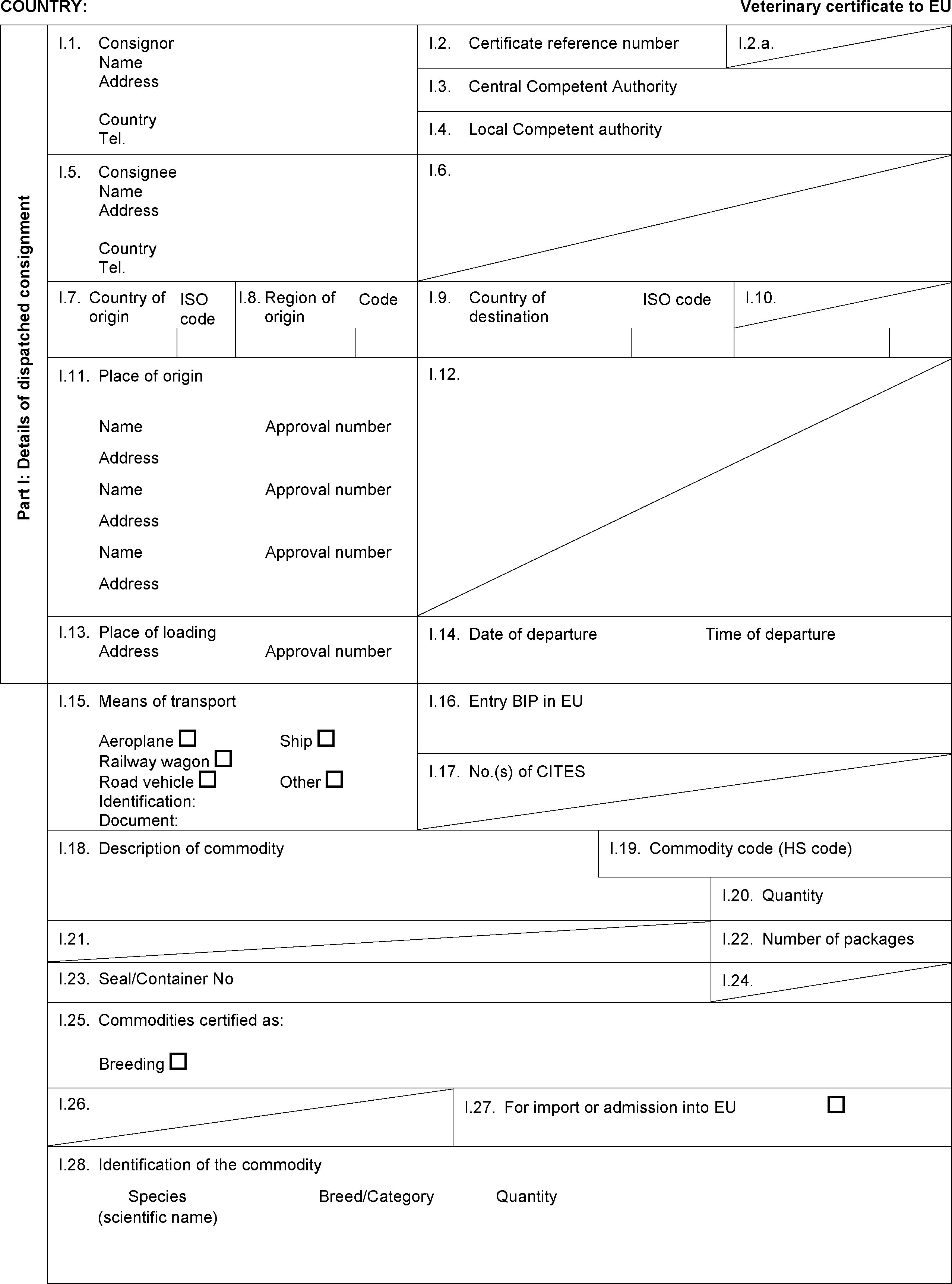

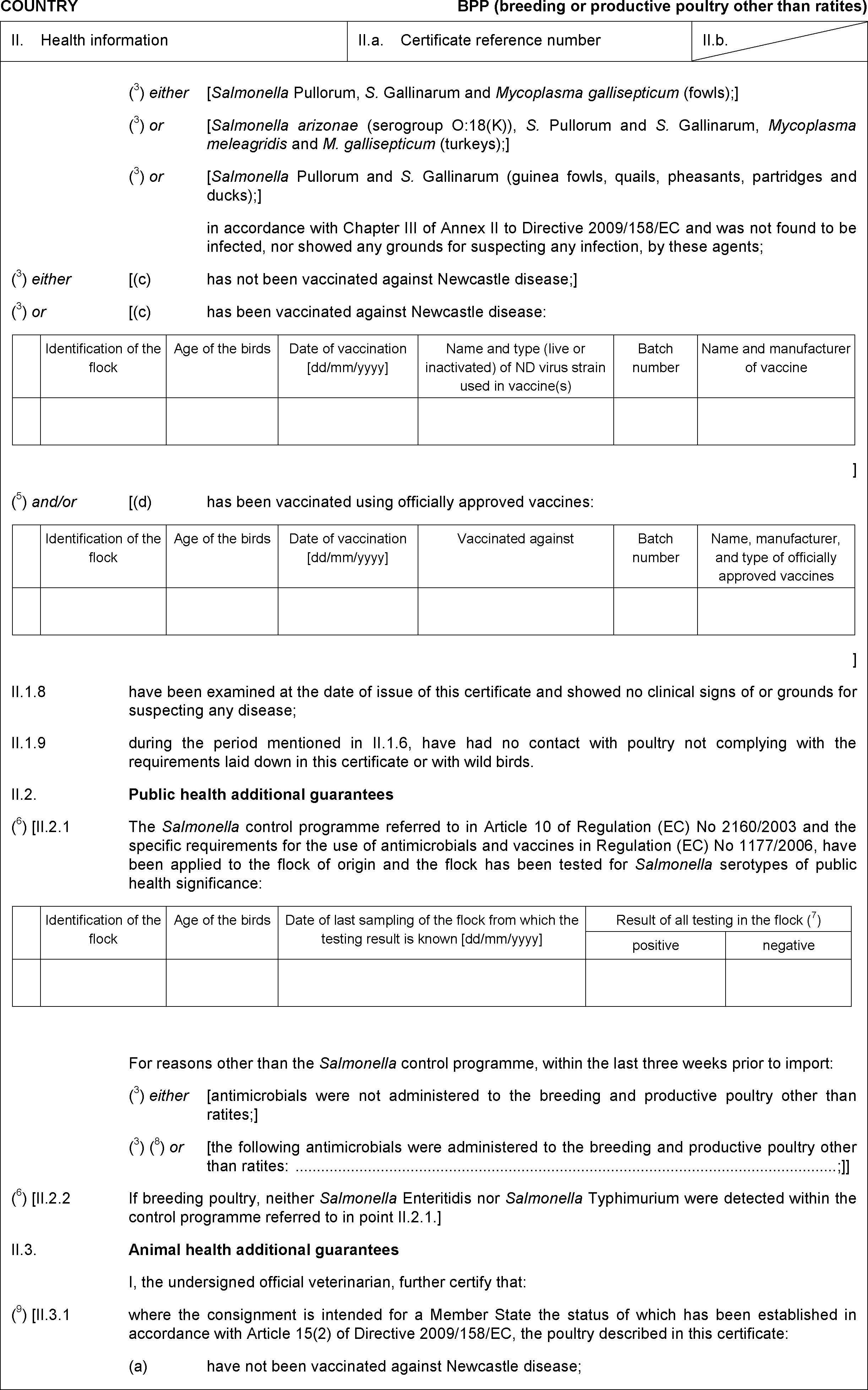


Model veterinary certificate for breeding or productive ratites (BPR)


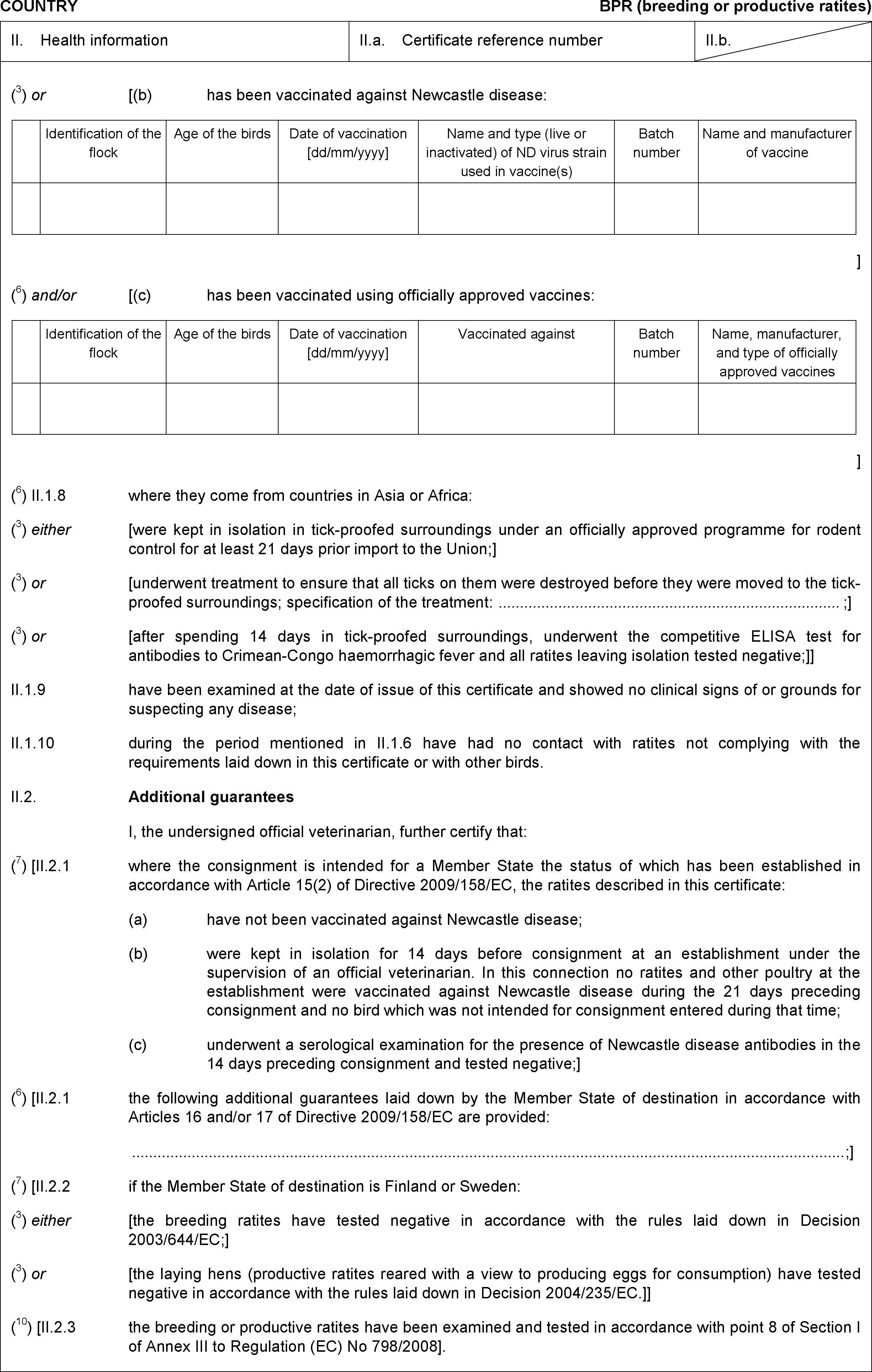


Model veterinary certificate for day-old chicks other than of ratites (DOC)






Model veterinary certificate for day-old chicks of ratites (DOR)

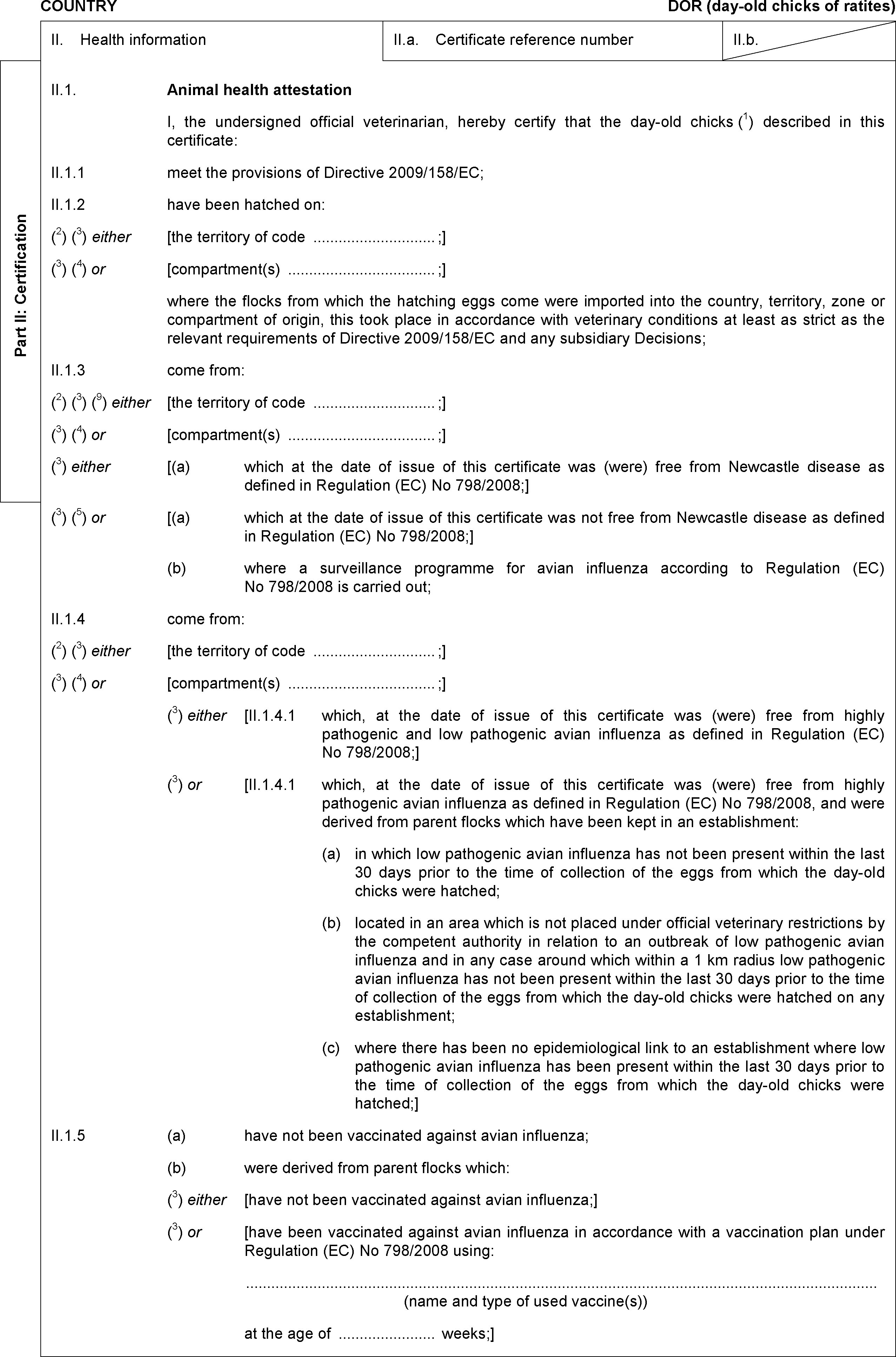


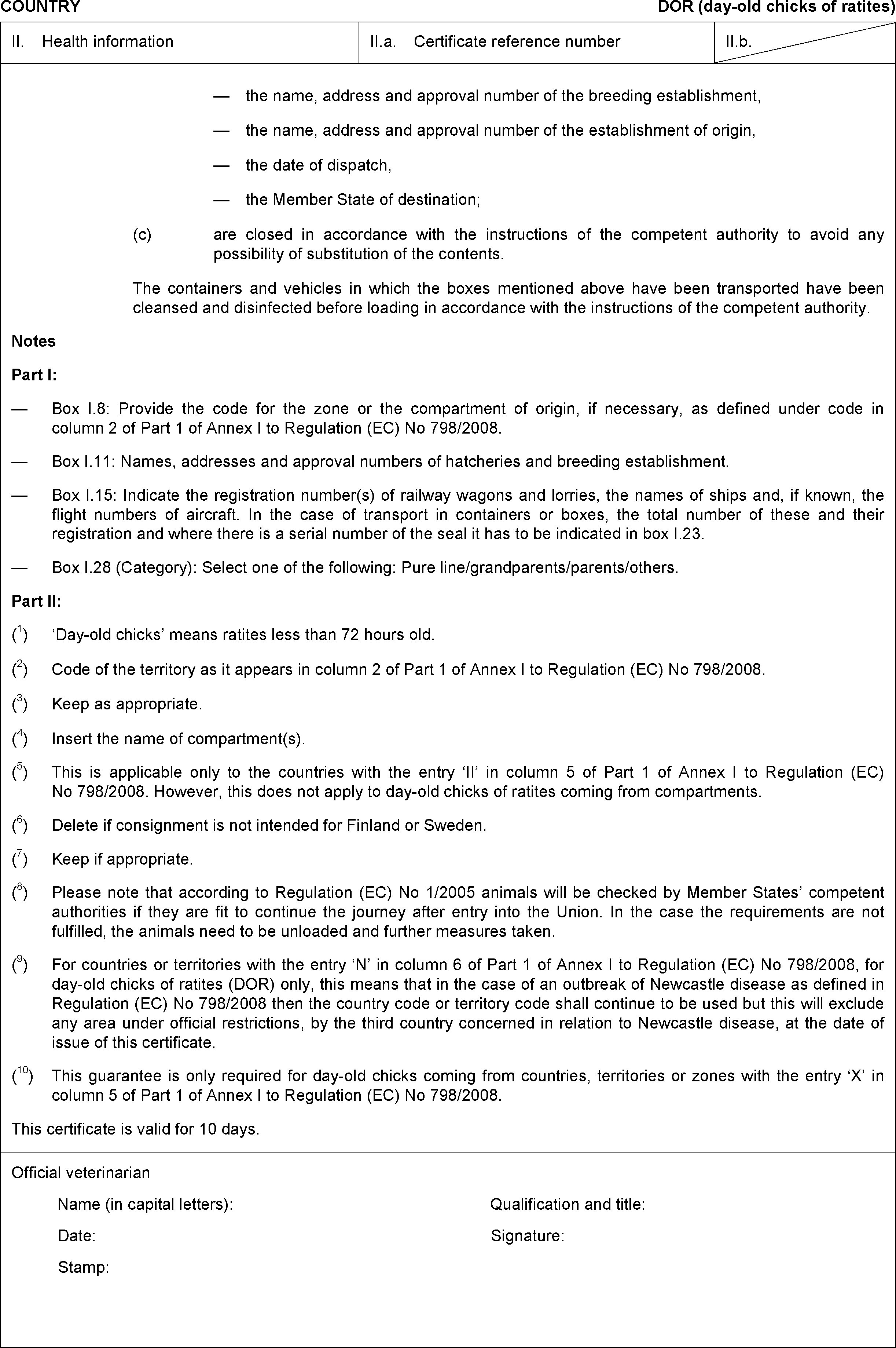
Model veterinary certificate for hatching eggs of poultry other than ratites (HEP)


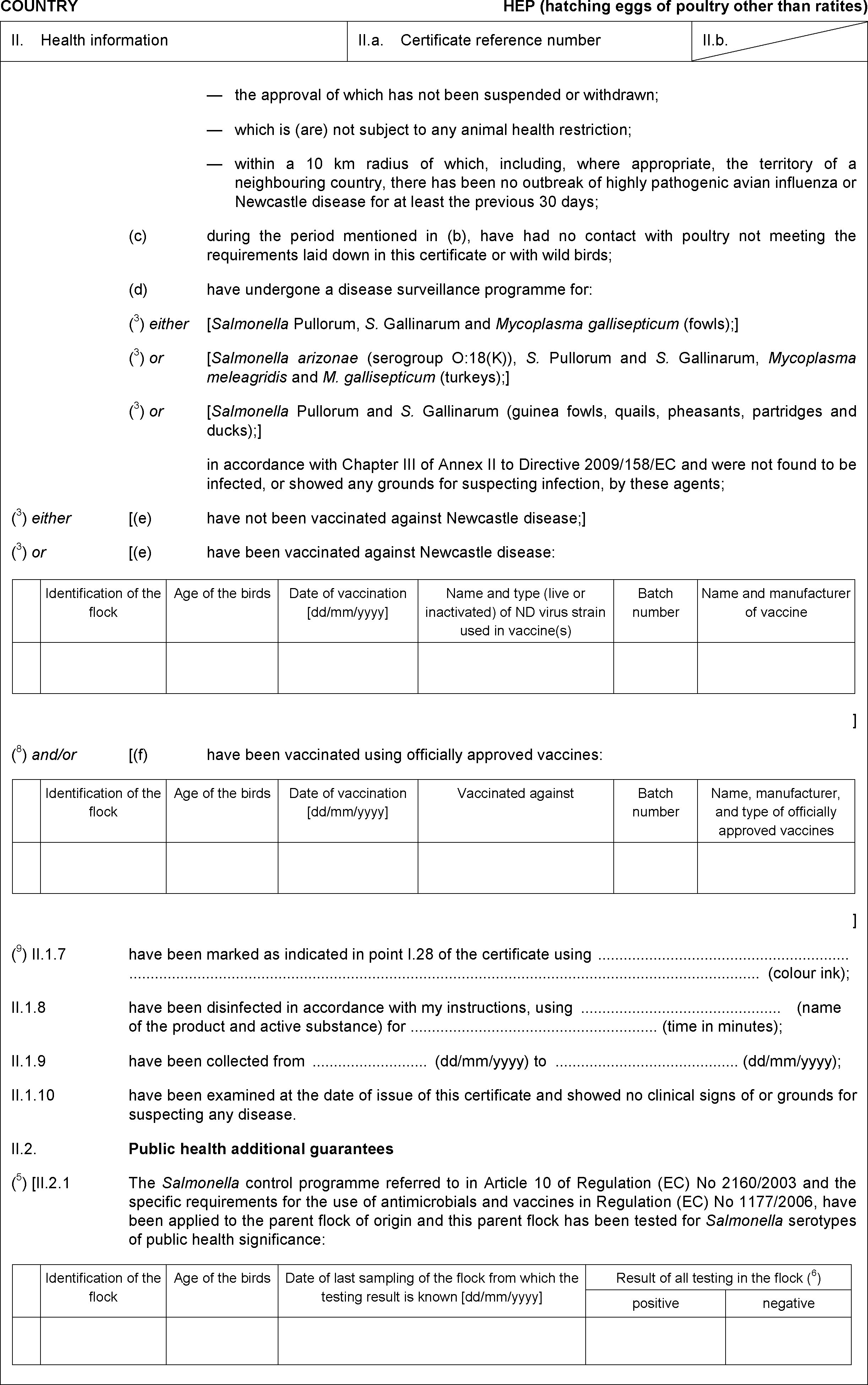
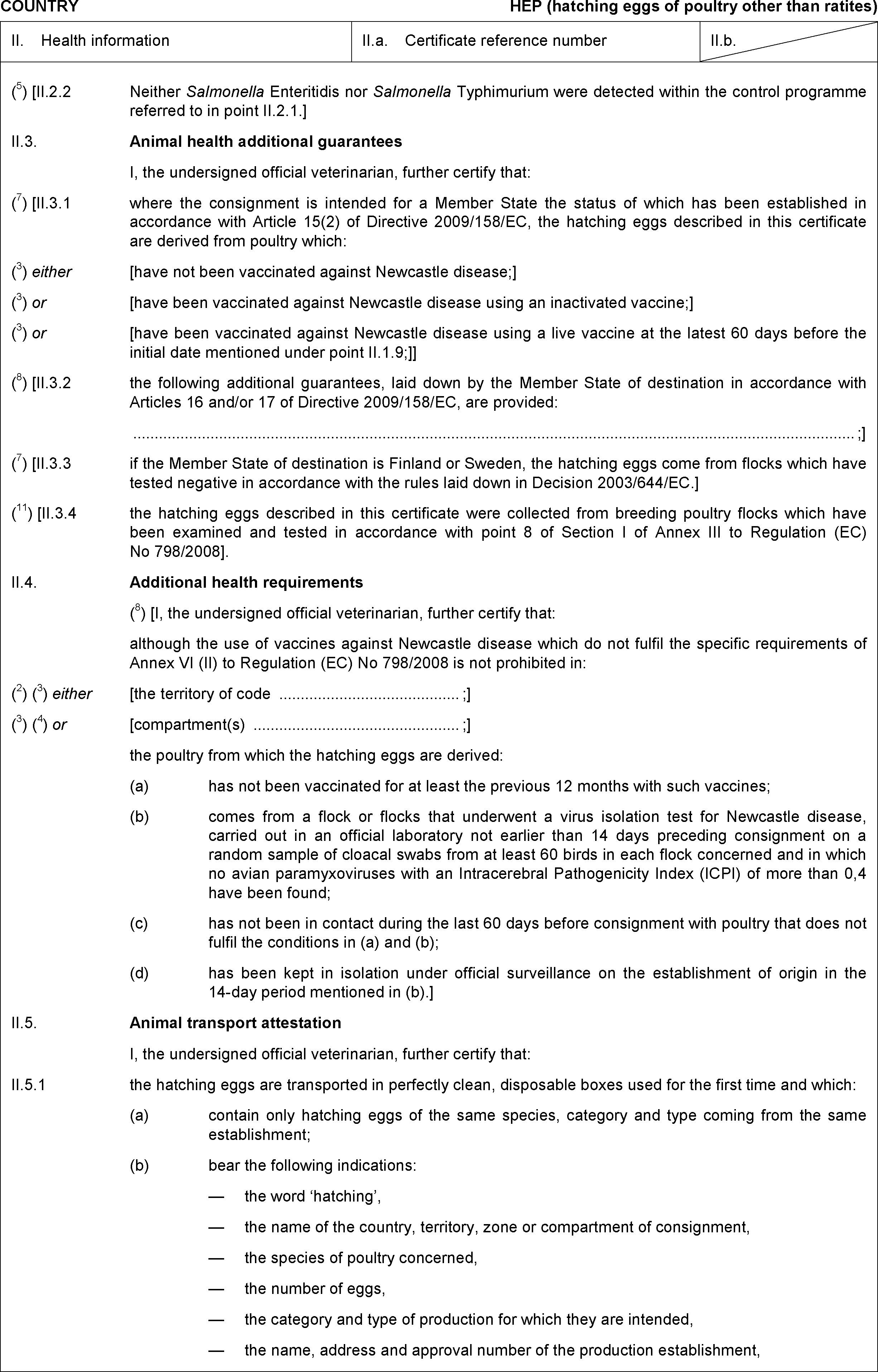

Model veterinary certificate for hatching eggs of ratites (HER)





Model veterinary certificate for specified pathogen-free eggs (SPF)


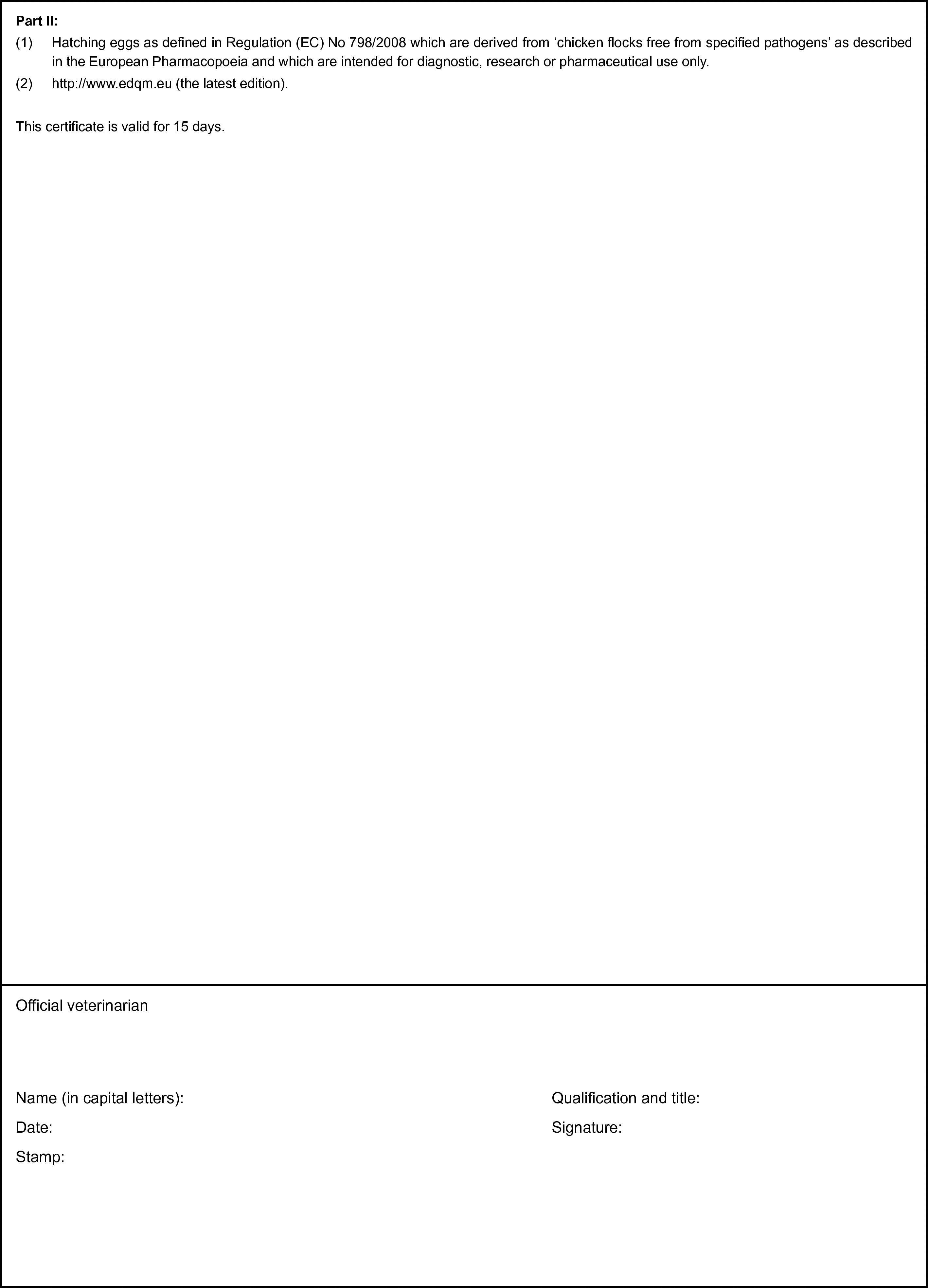
Model veterinary certificate for slaughter poultry and poultry for restocking game supplies other than ratites (SRP)
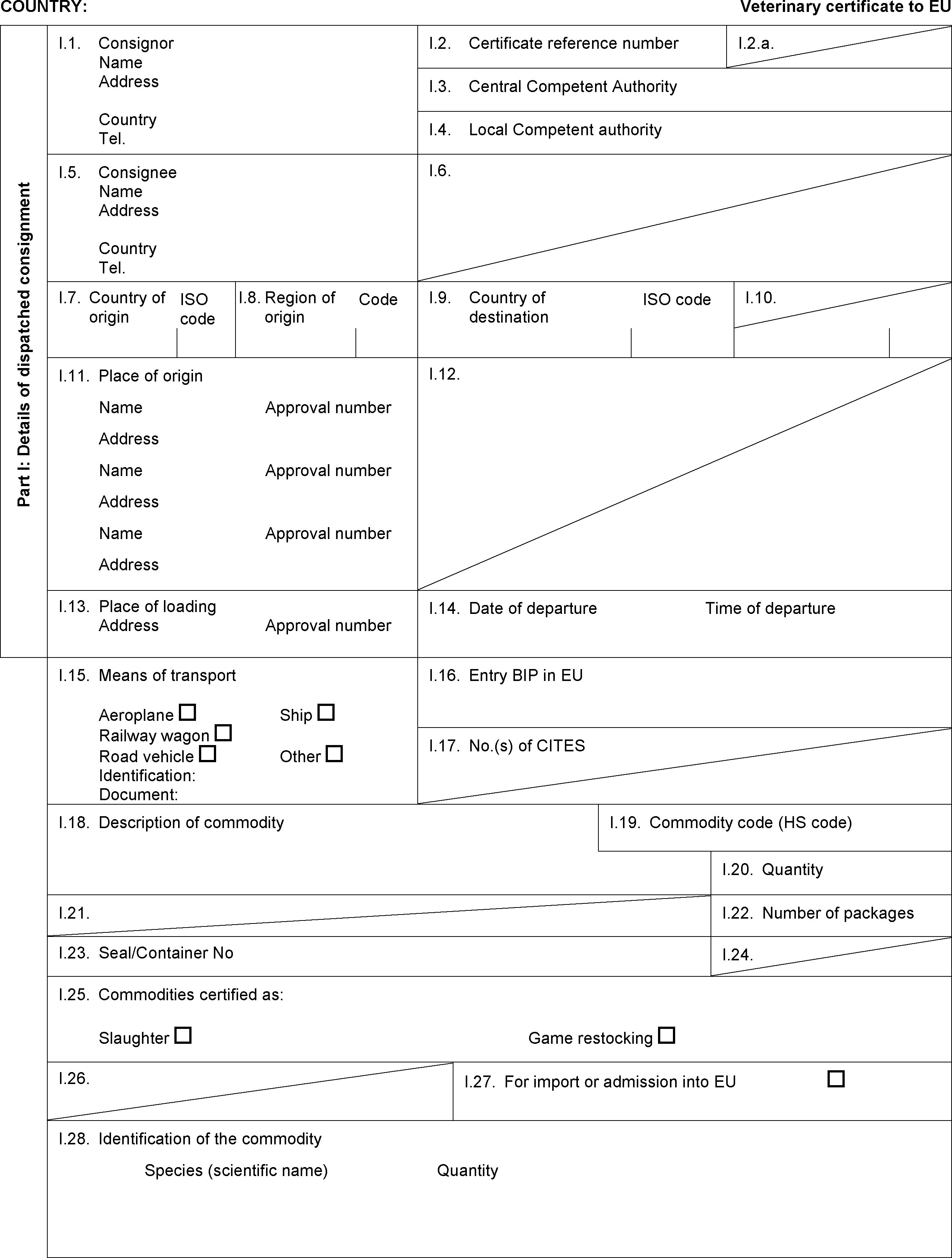



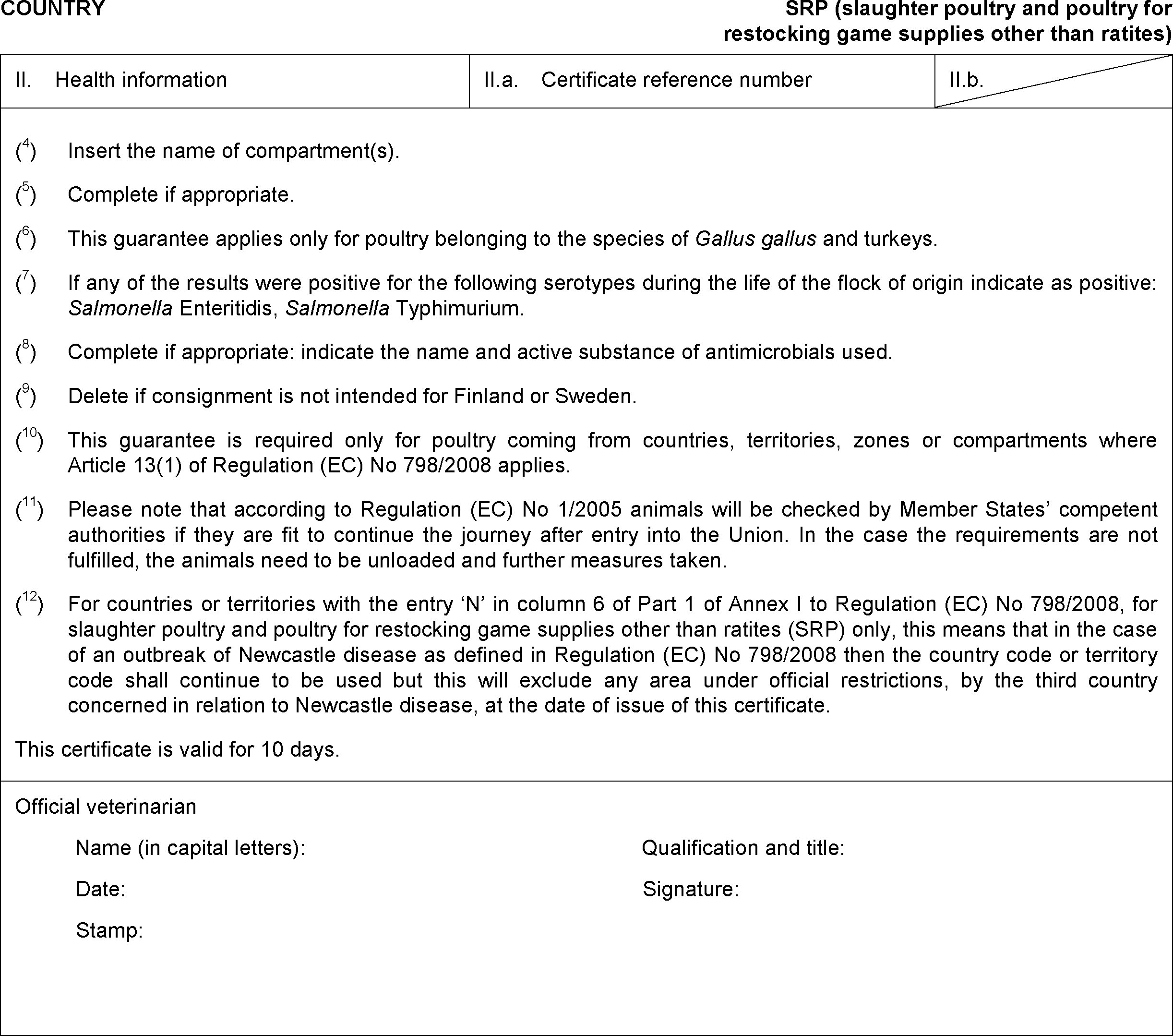
Model veterinary certificate for slaughter ratites (SRA)

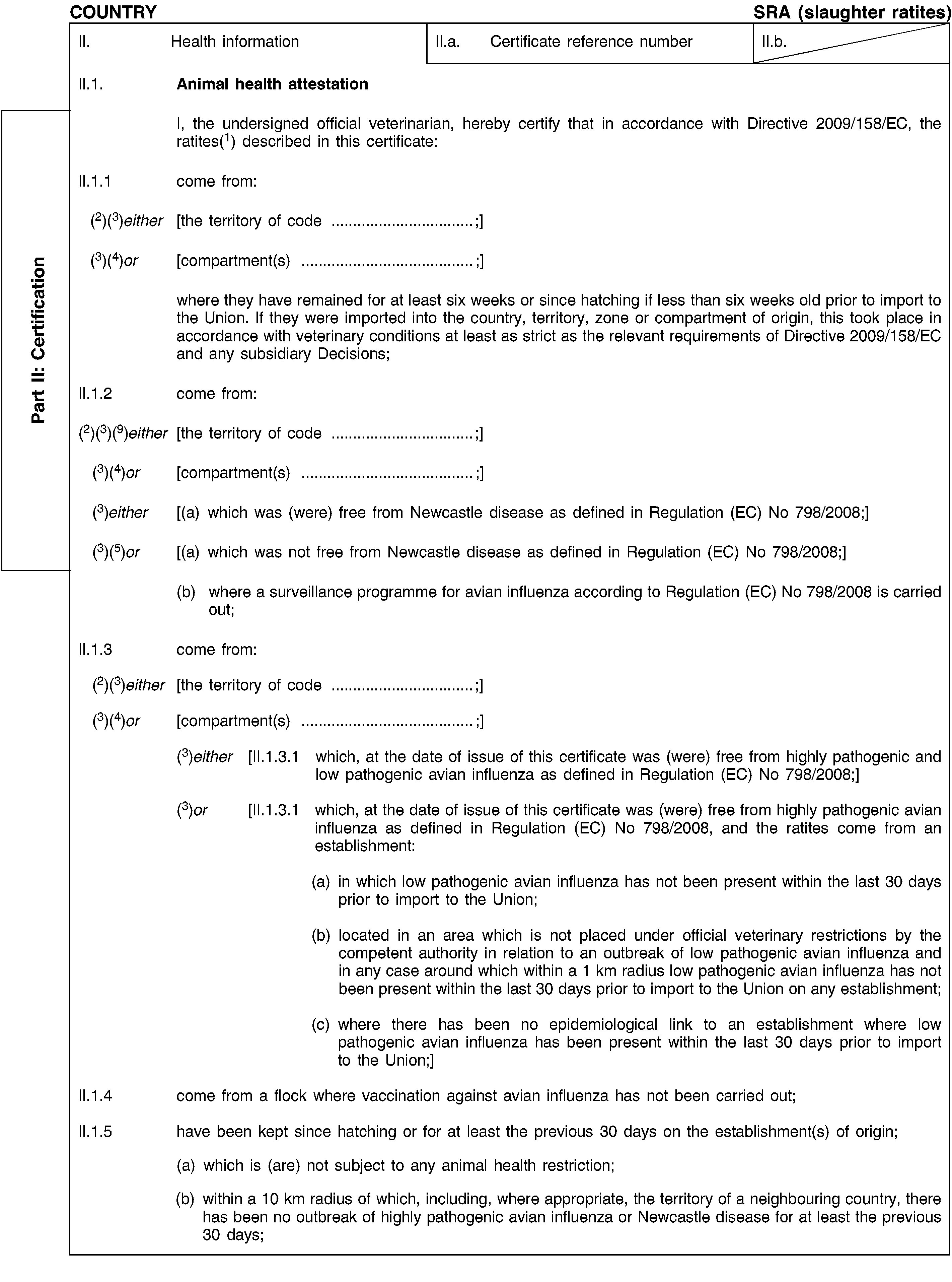



Model veterinary certificate for single consignments of less than 20 units of poultry other than ratites, hatching eggs and day-old chicks thereof (LT20)


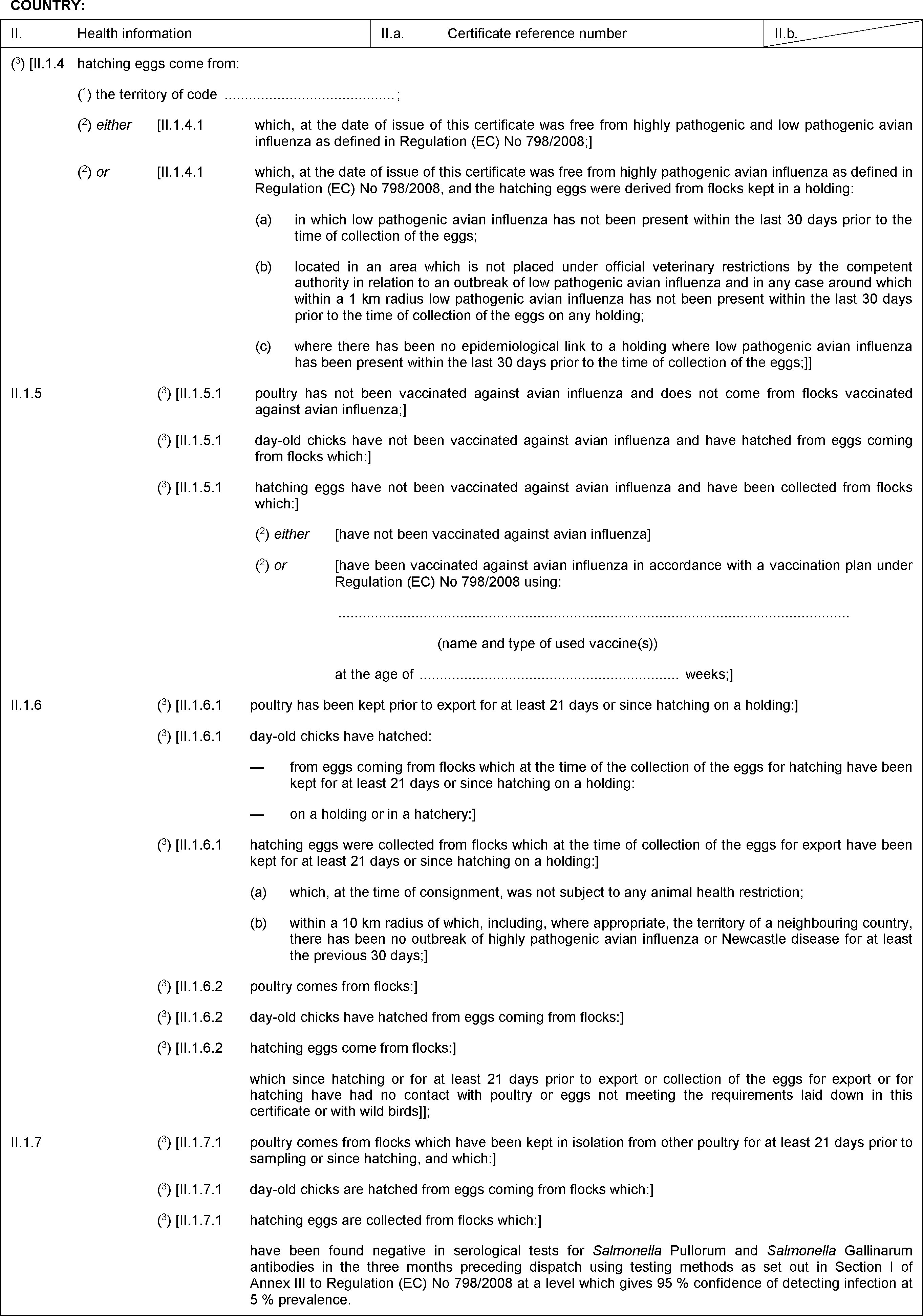

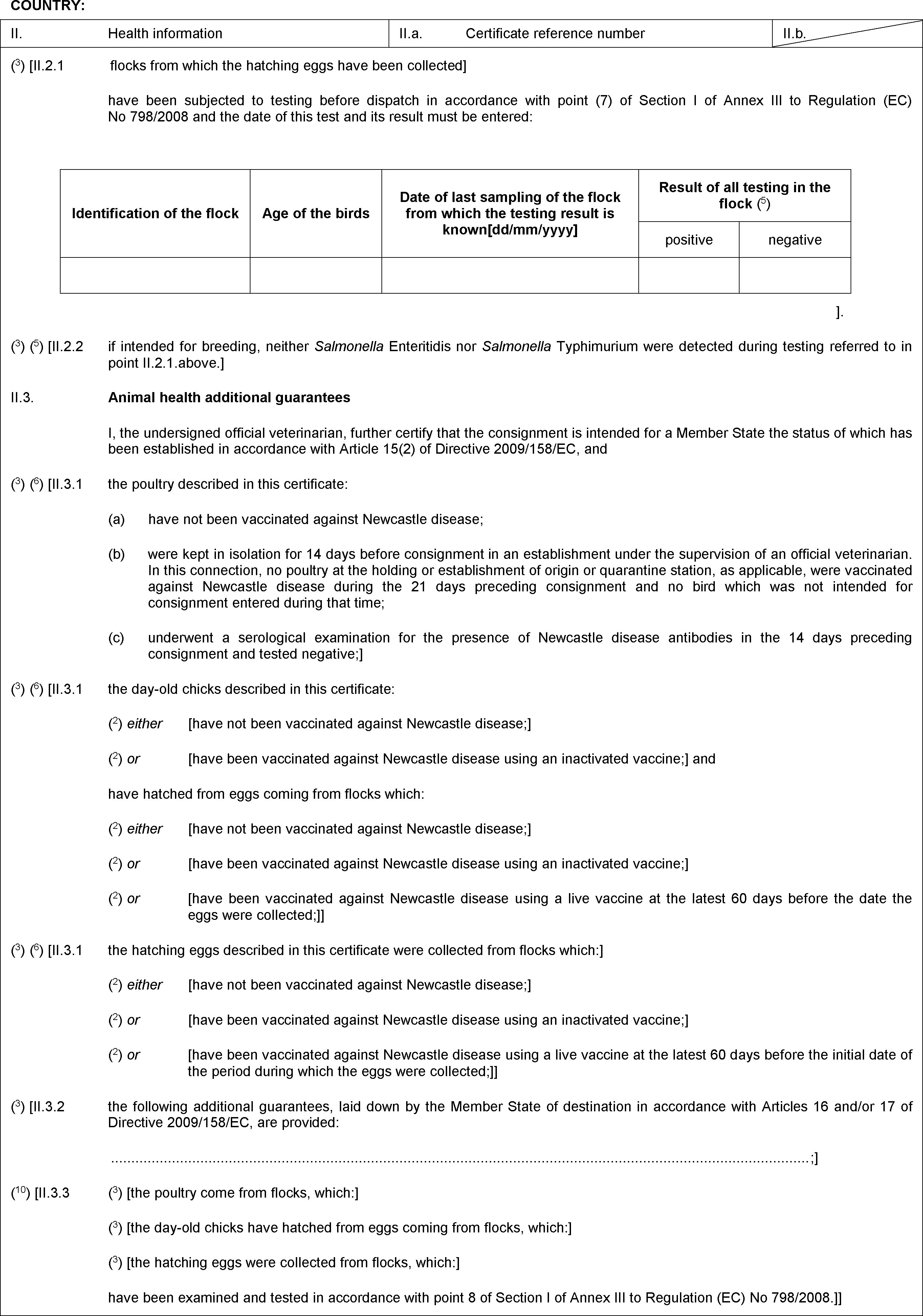
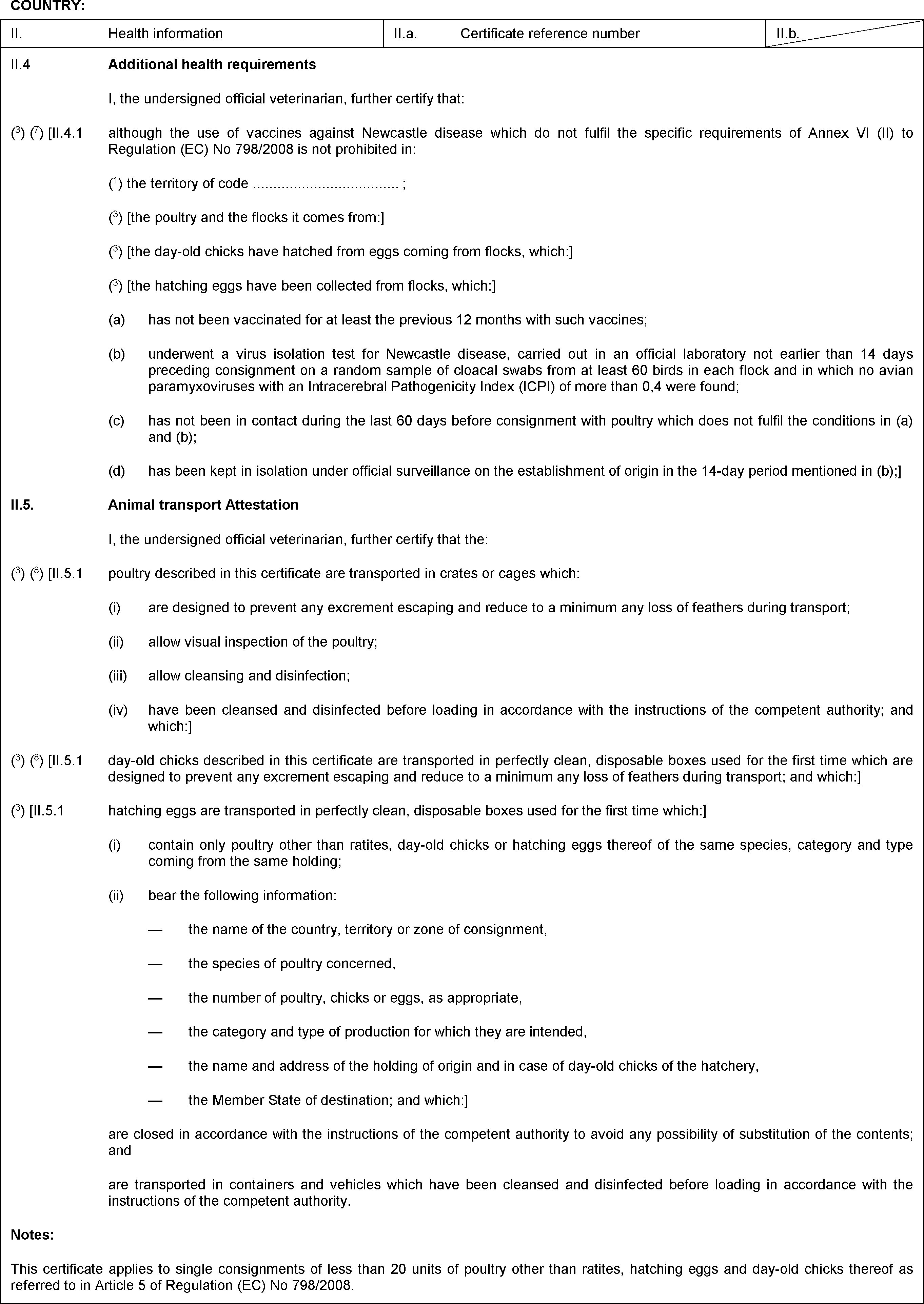


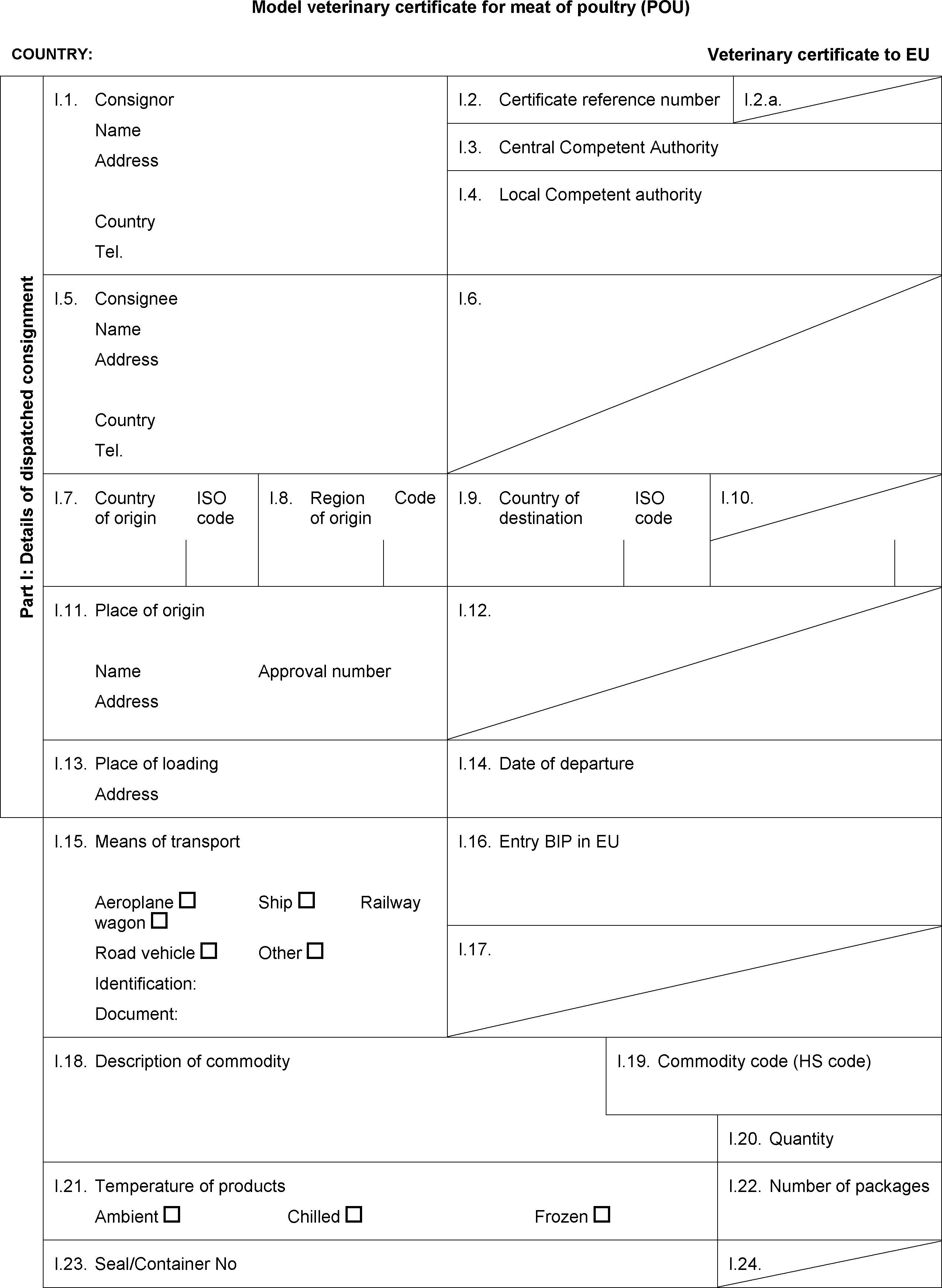




Model veterinary certificate for minced meat and mechanically separated meat of poultry (POU-MI/MSM)
(Not yet established)
Model veterinary certificate for meat of farmed ratites for human consumption (RAT)
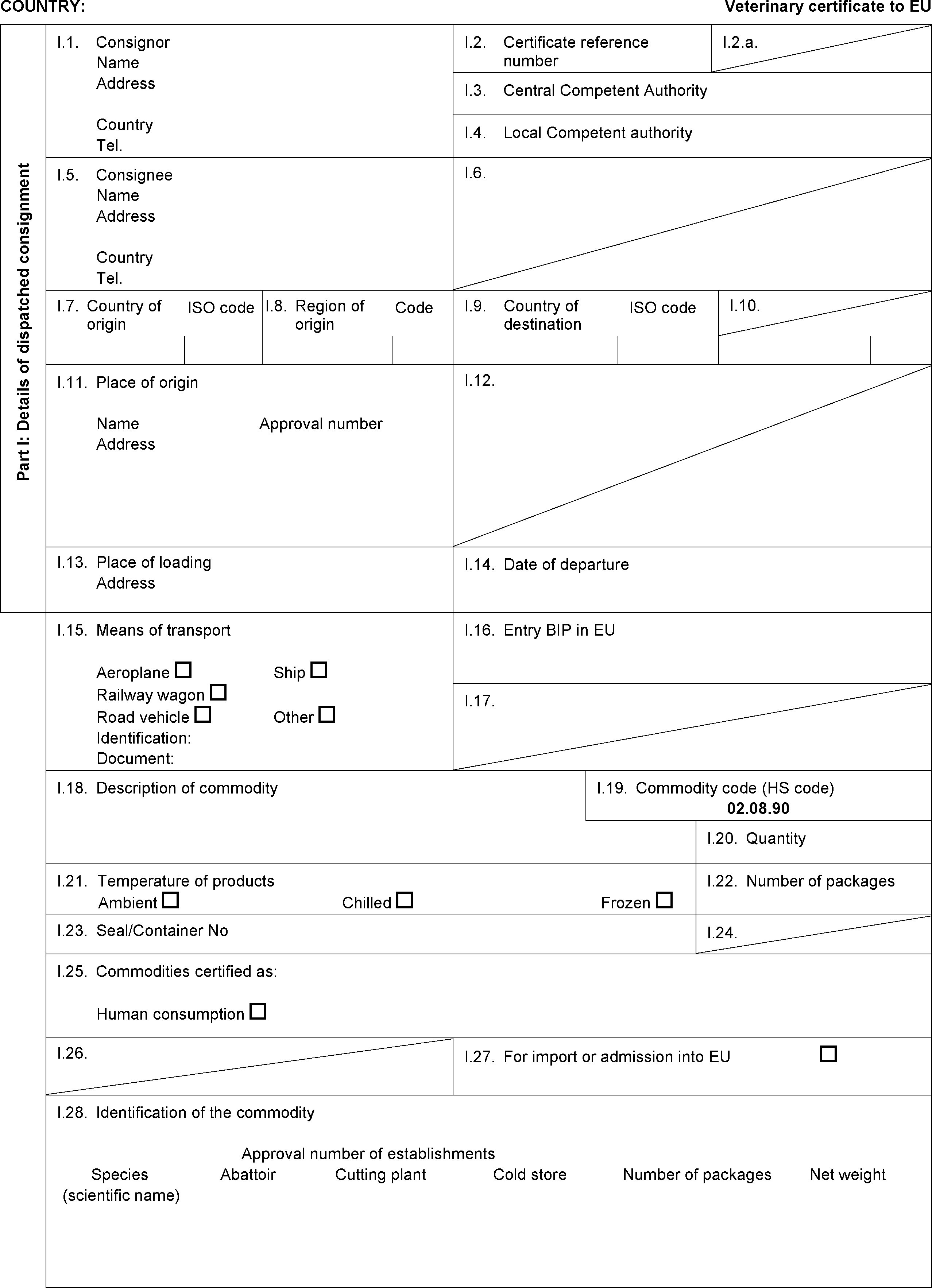
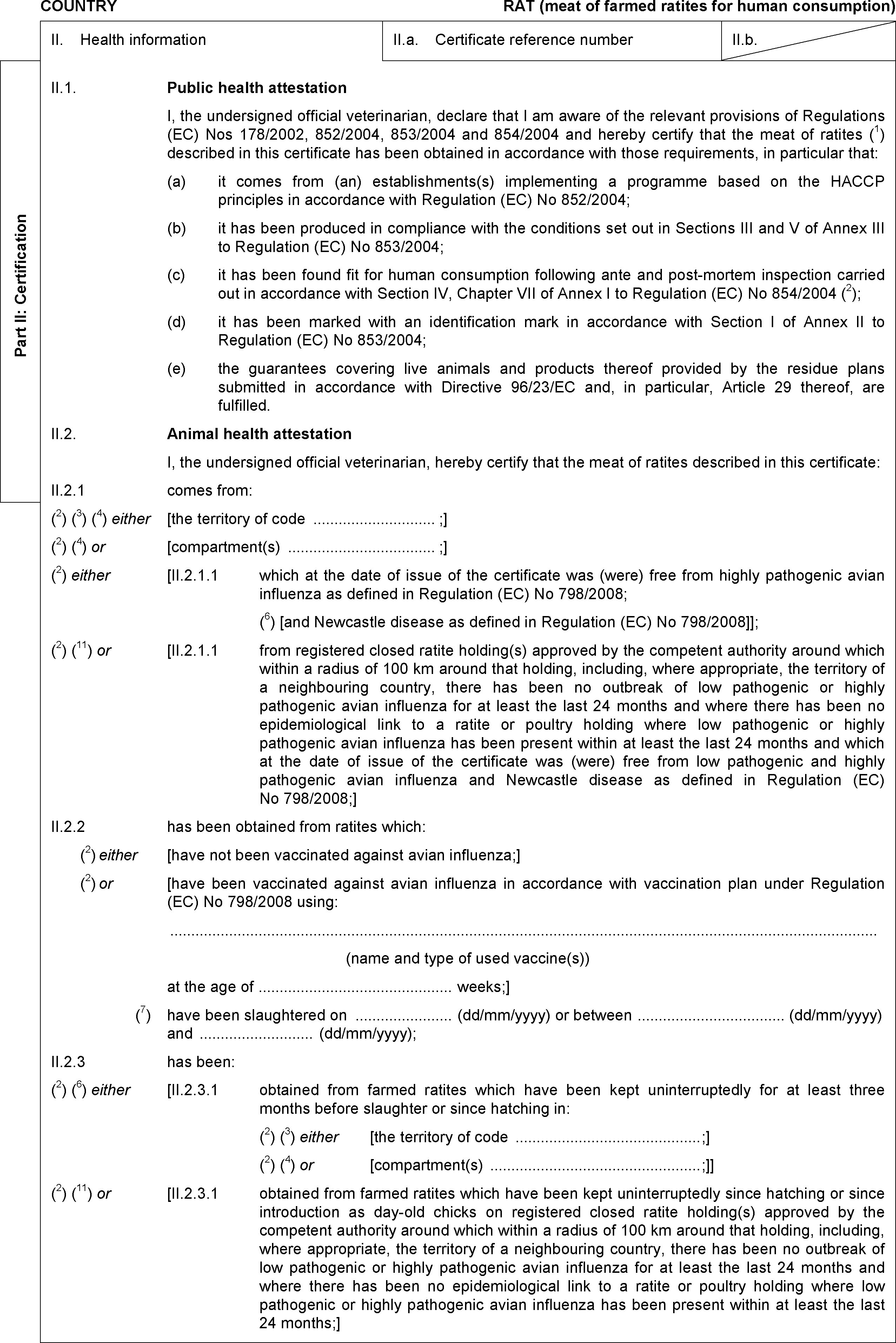
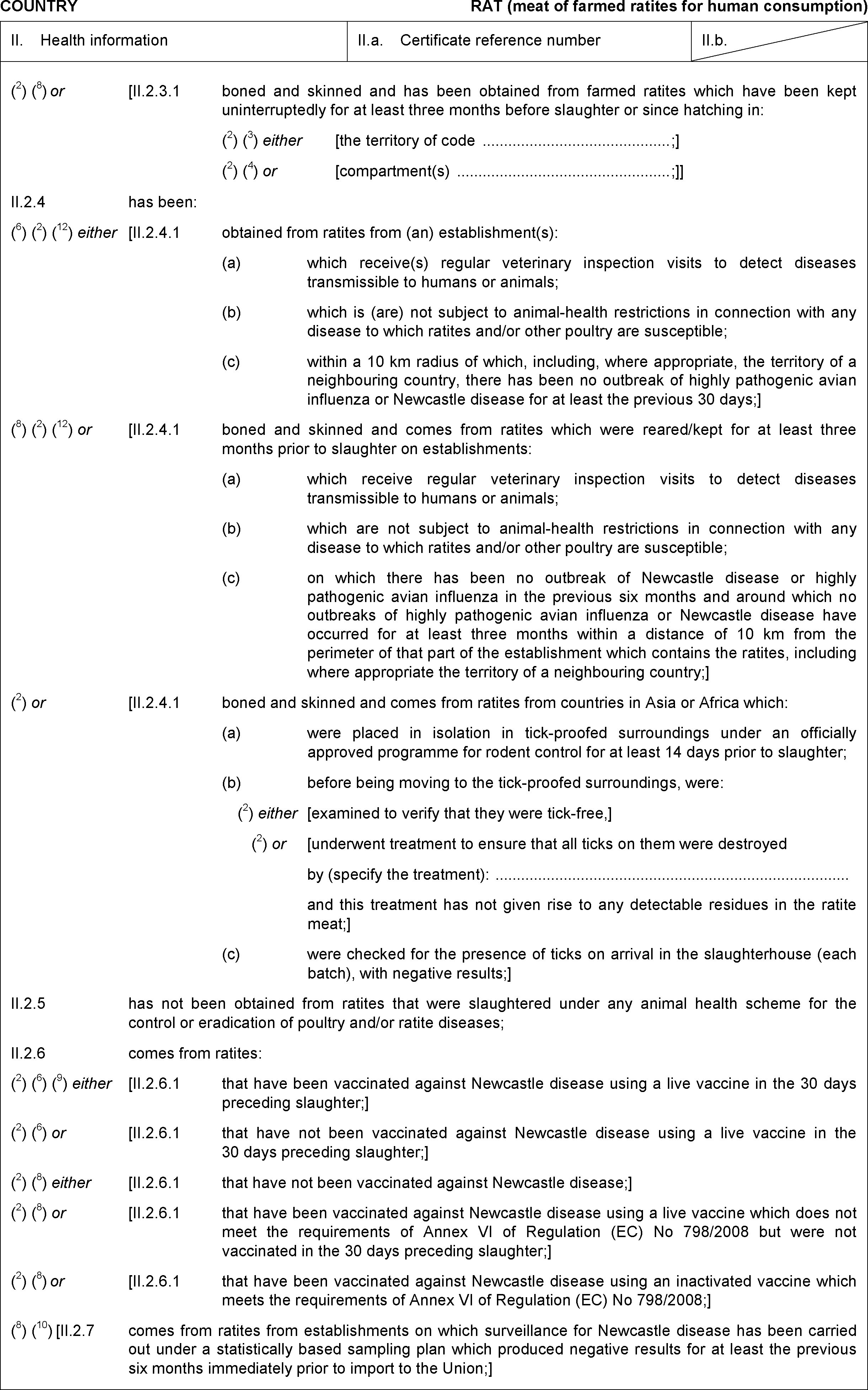
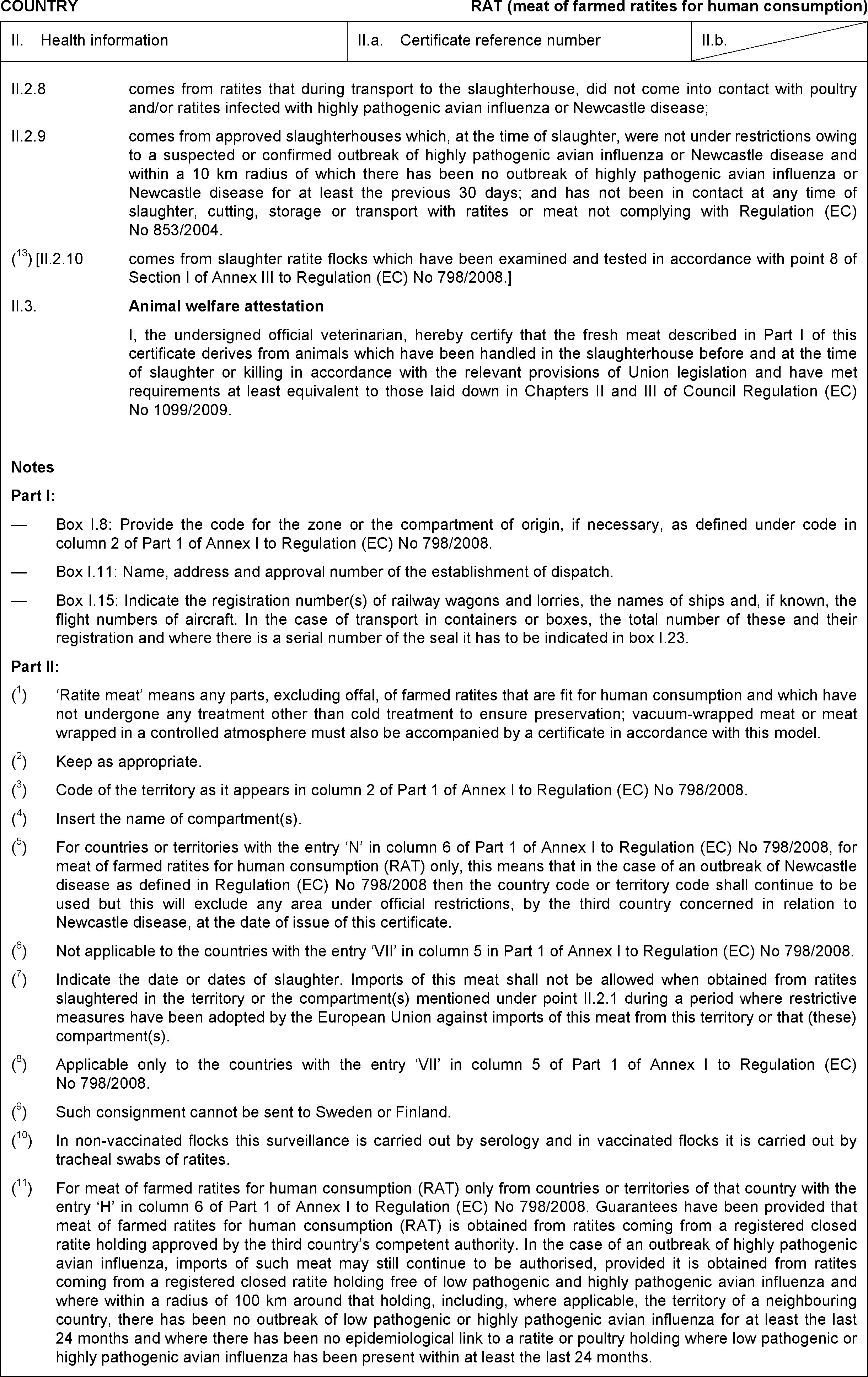

Model veterinary certificate for minced meat and mechanically separated meat of farmed ratites for human consumption (RAT-MI/MSM)
(Not yet established)
Model veterinary certificate for wild game-bird meat (WGM)
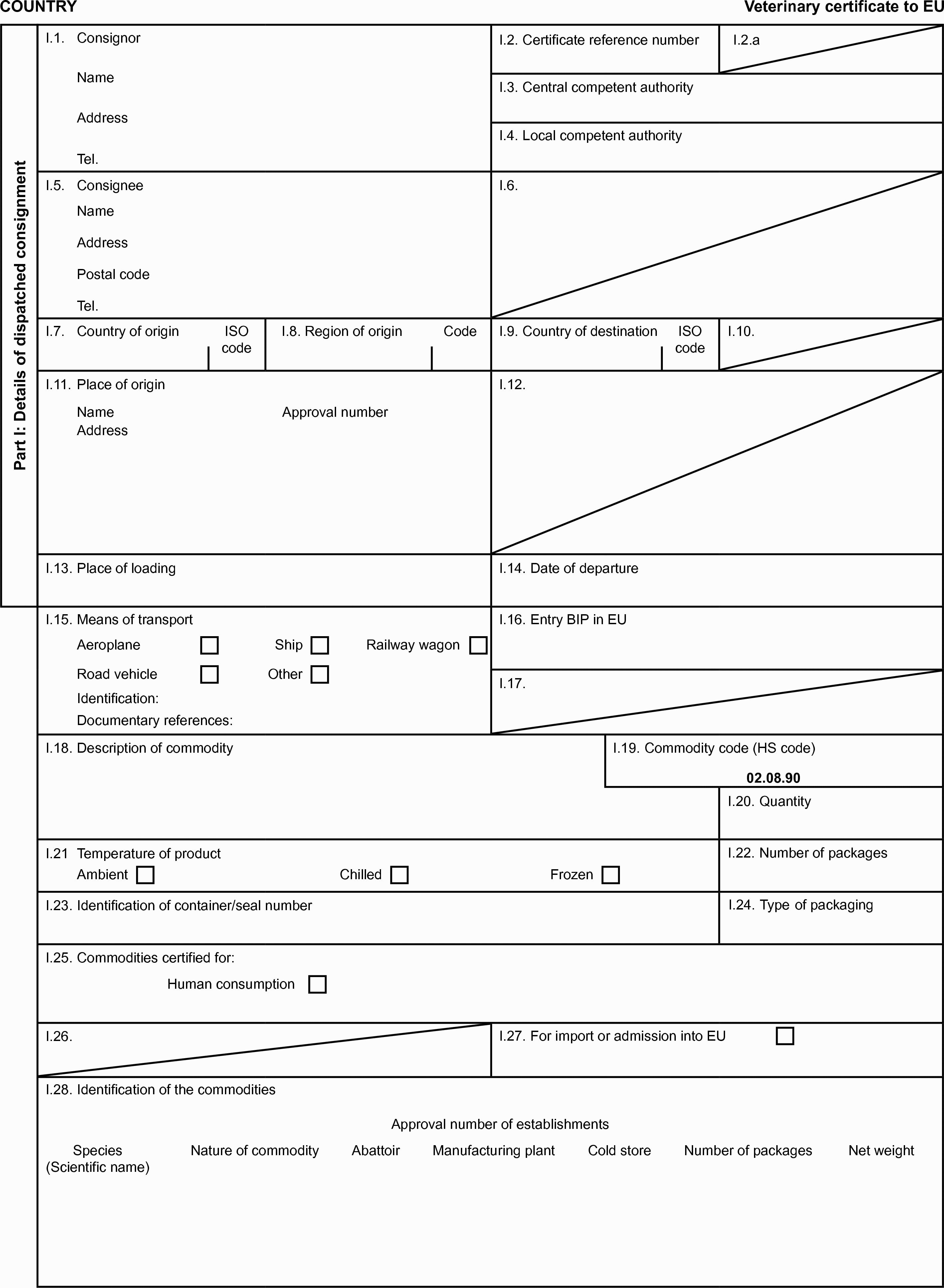


Model veterinary certificate for wild game-bird minced meat and mechanically separated meat (WGM-MI/MSM)
(Not yet established)
Model veterinary certificate for eggs (E)


Model veterinary certificate for egg products (EP)


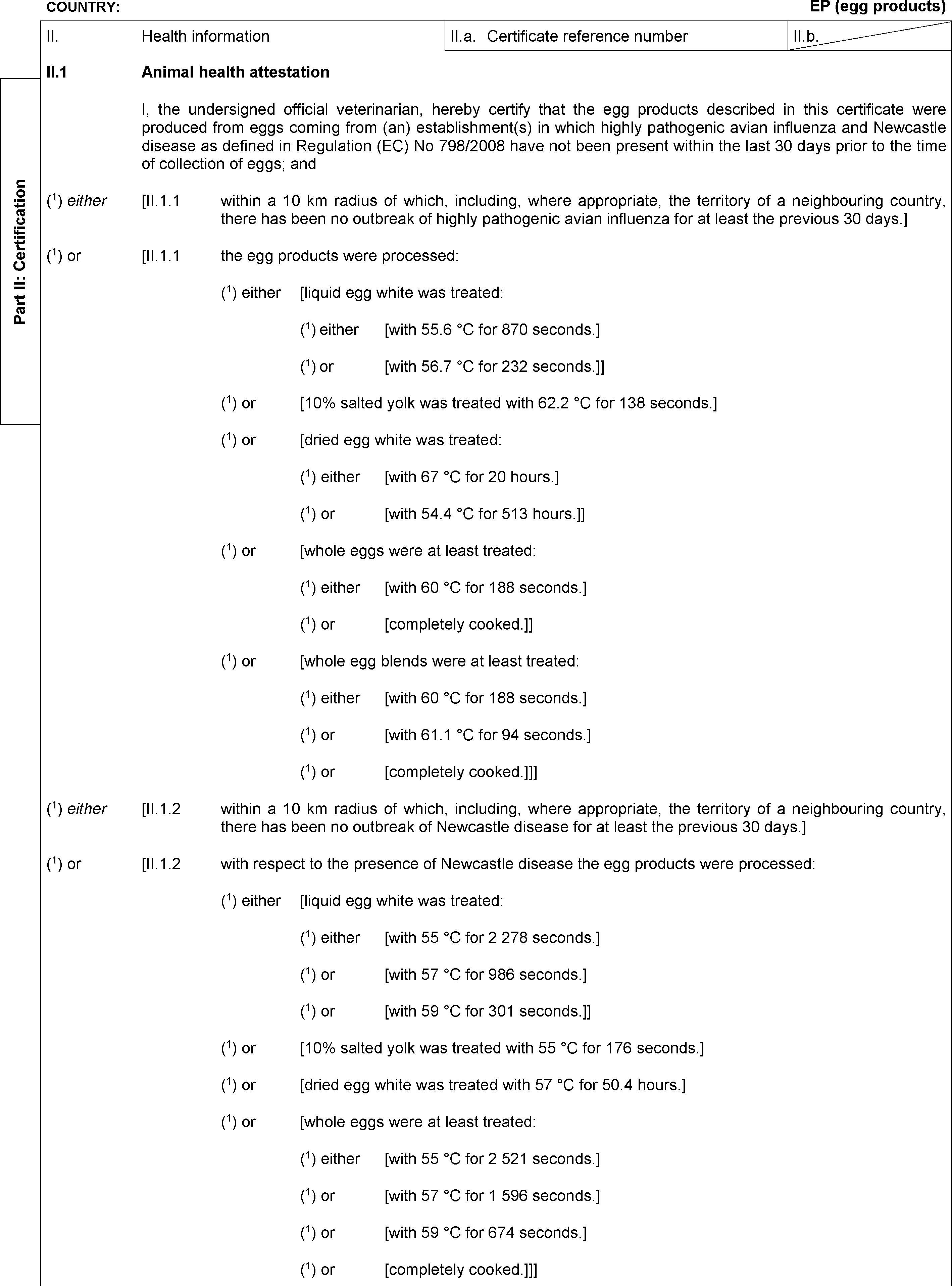
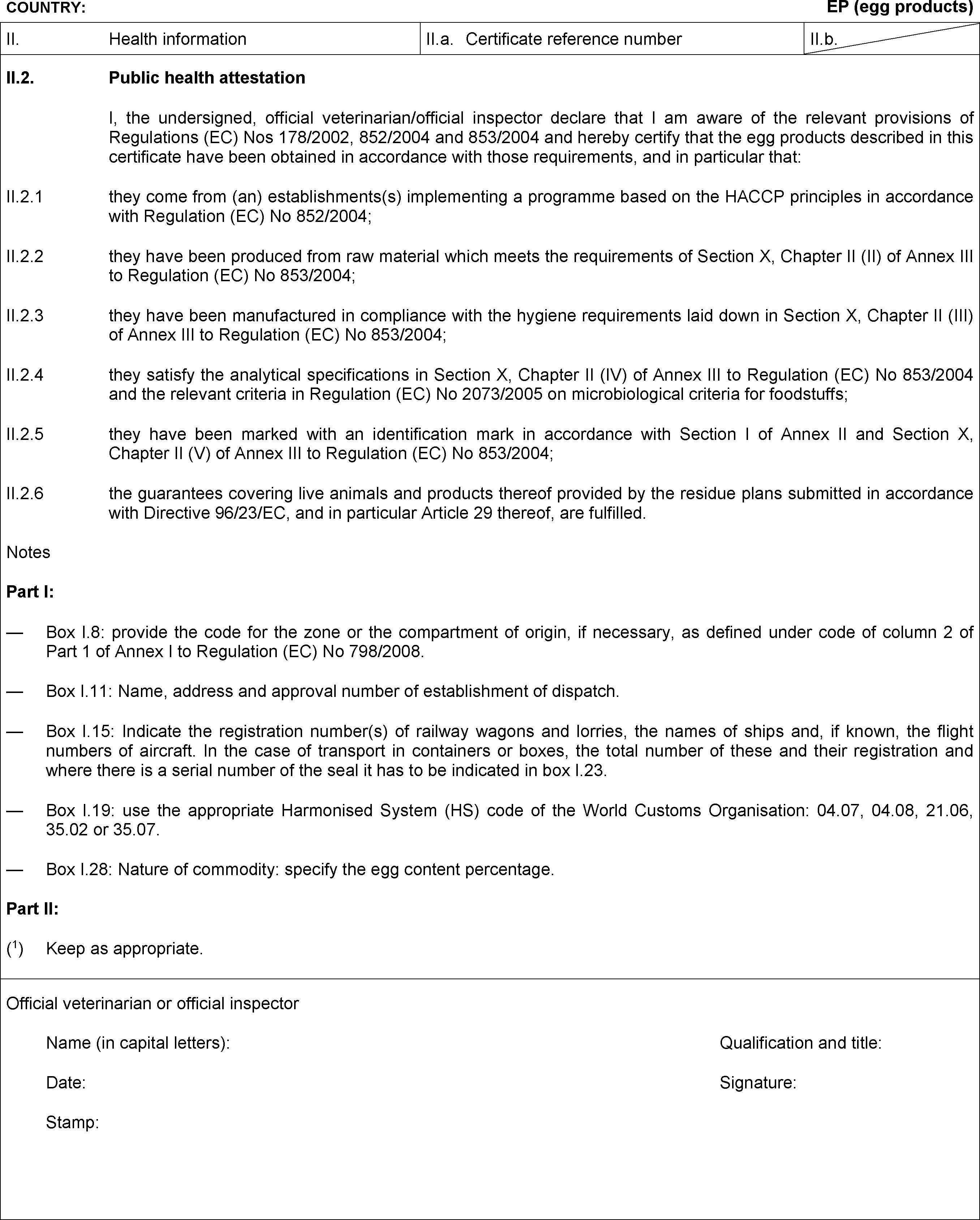
ANNEX II
(as referred to in Article 4)
(To be completed and attached to the veterinary certificate where transport of poultry and day-old chicks to the European Community border includes transport by ship, even for part of the journey.)
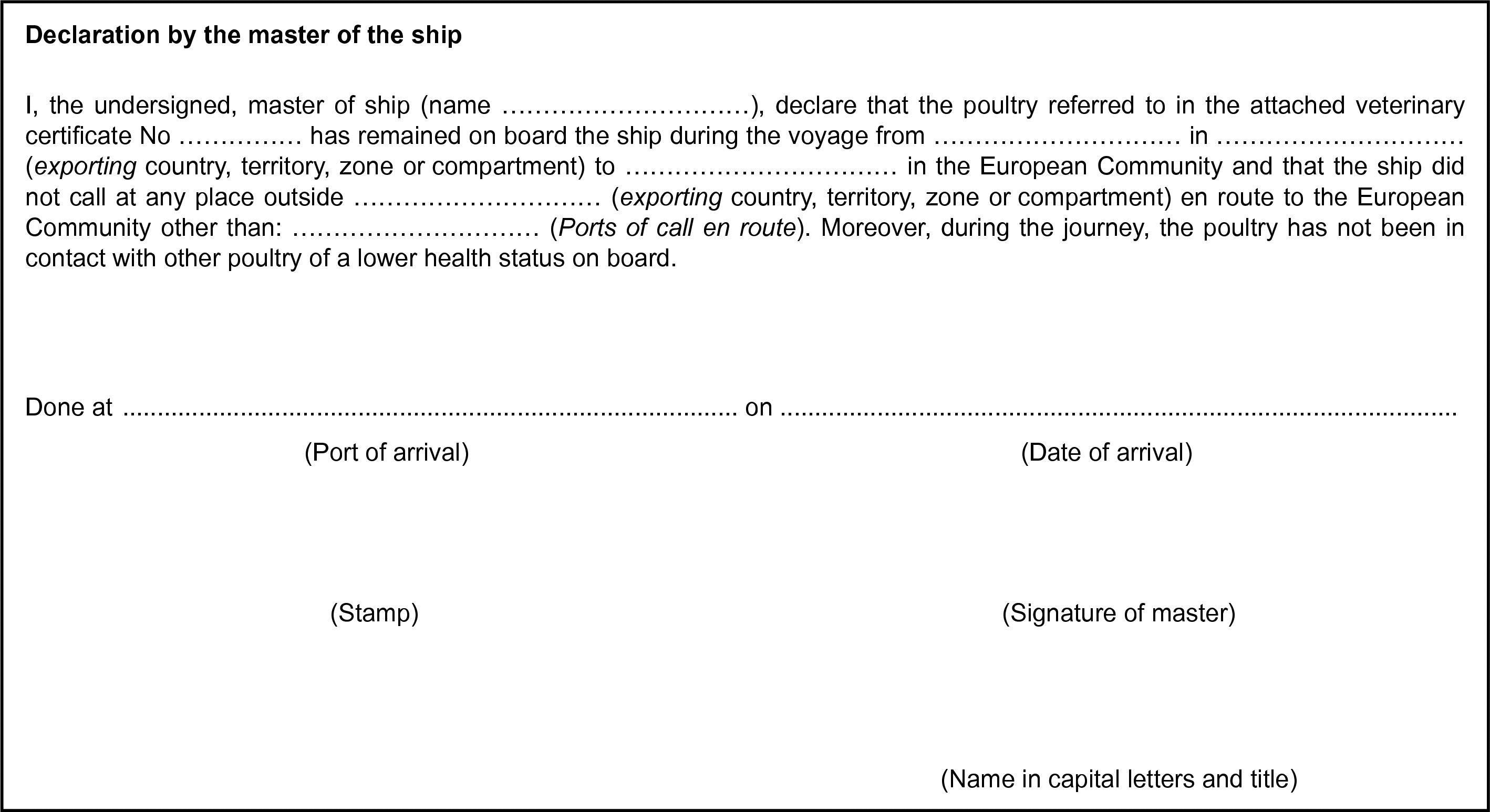
ANNEX III
COMMUNITY ACTS, INTERNATIONAL STANDARDS AND PROCEDURES FOR EXAMINATION, SAMPLING AND TESTING AS REFERRED TO IN ARTICLE 6
I. Before import into the Community
Methods for standardisation of materials and procedures for examination, sampling and testing for:
1. Avian influenza
— Diagnostic manual for avian influenza as laid down in Commission Decision 2006/437/EC ( 6 ); or
— Manual of Diagnostic Tests and Vaccines for Terrestrial Animals of the World Organisation for animal Health (OIE) ( 7 ).
2. Newcastle disease
— Annex III to Council Directive 92/66/EEC ( 8 ); or
— Manual of Diagnostic Tests and Vaccines for Terrestrial Animals of the World Organisation for animal Health (OIE);
— Where Article 12 of Directive ►M42 2009/158/EC ◄ applies, the sampling and testing methods must comply with the methods described in Annexes to Commission Decision 92/340/EEC ( 9 ).
3. Salmonella pullorum and Salmonella gallinarum
— Chapter III of Annex II to Directive ►M42 2009/158/EC ◄ ; or
— Manual of Diagnostic Tests and Vaccines for Terrestrial Animals of the World Organisation for animal Health (OIE).
4. Salmonella arizonae
— Chapter III of Annex II to Directive ►M42 2009/158/EC ◄ ; or
— Manual of Diagnostic Tests and Vaccines for Terrestrial Animals of the World Organisation for animal Health (OIE).
5. Mycoplasma gallisepticum
— Chapter III of Annex II to Directive ►M42 2009/158/EC ◄ ; or
— Manual of Diagnostic Tests and Vaccines for Terrestrial Animals of the World Organisation for animal Health (OIE).
6. Mycoplasma meleagridis
Chapter III of Annex II to Directive ►M42 2009/158/EC ◄ .
7. Salmonella of public health significance
Sampling shall be carried out in accordance with the sampling protocol laid down in point 2.2 of the Annex to Commission Regulation (EU) No 200/2010.
The detection method recommended by the EU reference laboratory (EURL) for salmonella in Bilthoven, the Netherlands, or an equivalent method shall be used. That method is described in the current version of Annex D of ISO 6579 (2002): ‘Detection of Salmonella spp. in animal faeces and in samples of the primary production stage’. For that detection method, a semi-solid medium (modified semi-solid Rappaport-Vassiladis medium, MSRV) is used as the single selective enrichment medium.
Serotyping shall be carried out following the Kauffmann-White scheme or an equivalent method.
8. Additional guarantees (X) in relation to certain third countries not free from Newcastle disease
8.1. In establishments referred to in point 8.2, the official veterinarian must:
(a) check the production and health records of the establishment;
(b) carry out a clinical inspection in each production unit, including an evaluation of its clinical history and clinical examinations of poultry — in particular of those that appear sick — in each production unit from which dispatch referred to in point 8.2 is intended;
(c) sample at least 60 tracheal or oropharyngeal and 60 cloacal swabs for laboratory investigations to be performed for checking the presence of Newcastle disease virus from poultry and ratites from each production unit from which dispatch referred to in point 8.2 is intended; if the number of birds present in that epidemiological unit is smaller than 60, swabs must be taken from all birds. In case of products referred to in point 8.2(c) this sampling may also take place at the slaughterhouse.
8.2. Point 8.1 applies in establishments from which it is intended to dispatch to the Union:
(a) breeding or productive poultry and breeding or productive ratites (BPP, BPR);
(b) day-old chicks of poultry, day-old chicks of ratites, hatching eggs of poultry or ratites and eggs for consumption (DOC, DOR, HEP, HER, E);
(c) meat obtained from poultry and ratites kept on such holdings (POU, RAT).
8.3. The procedures provided for in point 8.1 must be carried out:
(a) for the commodities referred to in points (a) and (c) of point 8.2, within not more than 72 hours prior to dispatch to the Union or prior to the slaughter of the poultry and ratites;
(b) for the commodities referred to in point (b) of point 8.2, at intervals of 15 days or in case of infrequent dispatch to the Union, not more than seven days before collection of the hatching eggs.
8.4. The procedures referred to in point 8.1 must have a favorable outcome and the laboratory investigations referred to above must be performed in an official laboratory, give negative results and be available before dispatch to the Union of any of the commodities listed in points 8.2.
II. After import into the Community
Sampling and testing procedures for avian influenza and Newcastle disease:
During the period referred to in point II.1 of Annex VIII, the official veterinarian shall take samples from the imported poultry for virological examination, to be tested as follows:
— Between the seventh and the fifteenth day following the date of commencement of the isolation period, cloacal swabs must be taken from all birds where the consignment contains less than 60 birds, and from at least 60 birds where consignments contain more than 60 birds;
— Testing of samples must be carried out in official laboratories designated by the competent authority, using diagnostic procedures for:
—
(i) avian influenza as laid down in the diagnostic manual in Commission Decision 2006/437/EC;
(ii) Newcastle disease as laid down in Annex III to Council Directive 92/66/EEC.
III. General requirements
— Samples may be pooled, subject to a maximum of five samples from individual birds in each pool.
— Virus isolates must be sent without delay to the national reference laboratory.
ANNEX IV
(as referred to in Article 8(2)(d), Article 9(2)(b) and Article 10
REQUIREMENTS FOR AVIAN INFLUENZA SURVEILLANCE PROGRAMMES AND INFORMATION TO BE SUBMITTED ( 10 )
I. Requirements for avian influenza surveillance in poultry carried out in third countries, territories, zones or compartments as referred to in Article 10.
A. surveillance for avian influenza in poultry:
1. Description of objectives
2. Third country, territory, zone or compartment (keep as appropriate):
3. Type of surveillance:
— Serological surveillance
— Virological surveillance
— Targeted avian influenza subtypes
4. Sampling criteria:
— Targeted species (for example, s, chicken, partridges)
— Targeted categories (for example, breeders, layers)
— Targeted husbandry systems (for example, commercial establishments, backyard flocks)
5. Statistical basis for number of establishments sampled:
— Number of establishments in area
— Number of establishments per category
— Number of establishments to be sampled per poultry category
6. Frequency of sampling
7. Number of samples taken per establishment/shed
8. Time period for sampling
9. Type of samples taken (tissue, faeces, cloacal/oropharyngeal/tracheal swabs)
10. Laboratory tests used (for example, AGID, PCR, HI, Virus isolation.)
11. Indication of laboratories carrying out testing at central, regional or local level (keep as appropriate)
Indication of reference laboratory carrying out confirmatory testing (avian influenza national reference laboratory, OIE or Community reference laboratory for avian influenza)
12. Reporting system/protocol used for avian influenza surveillance results (include results where available)
13. Follow-up investigations of positive results for subtypes H5 and H7.
B. where available information on surveillance for avian influenza in wild birds to assess risk factors for avian influenza introduction into poultry:
1. Type of surveillance:
— Serological surveillance
— Virological surveillance
— Targeted avian influenza subtypes
2. Sampling criteria
3. Targeting of wild bird species (indicate species names in Latin)
4. Targeting of selected areas
5. Information referred to in point 6 and points 8 to 12 of Part I.A.
II. Avian influenza surveillance to be carried out following the occurrence of an outbreak of that disease in a third country, territory, zone or compartment previously free from that disease, as referred to in Articles 8(2)(d) and 9(2)(b)
Surveillance for avian influenza must provide at least the confidence by a randomised representative sample of the populations at risk to demonstrate the absence of infection taking into account the specific epidemiological circumstances in relation to the occurred outbreak(s).
ANNEX V
(as referred to in Article 11(a))
INFORMATION TO BE SUBMITTED BY A THIRD COUNTRY VACCINATING AGAINST AVIAN INFLUENZA ( 11 )
I. Requirements for vaccination plans carried out in a third country, territory, zone or compartment as referred to in Article 11
1. Country, territory, zone or compartment (keep as appropriate)
2. Disease history (previous outbreaks in poultry or cases in wild birds of HPAI/LPAI)
3. Description of the reasons for the decision on the introduction of vaccination
4. Risk assessment based on:
— Avian influenza outbreak within that third country, territory, zone or compartment (keep as appropriate)
— Avian influenza outbreak in a nearby country
— Other risk factors such as certain areas, type of poultry husbandry or categories of poultry or other captive birds
5. Geographical area where vaccination is carried out
6. Number of establishments in vaccination area
7. Number of establishments where vaccination is carried out, if different from number in point 6
8. Species and categories of poultry or other captive birds in vaccination territory, zone or compartment
9. Approximate number of poultry or other captive birds in the establishments referred to in point 7
10. Summary of the vaccine characteristics
11. Authorisation, handling, manufacture, storage, supply, distribution and sale of avian influenza vaccines on national territory
12. Implementation of a DIVA strategy
13. Envisaged duration of vaccination campaign
14. Provisions and restrictions on the movements of vaccinated poultry and poultry products derived from vaccinated poultry or vaccinated other captive birds
15. Clinical and laboratory tests carried out in the establishments vaccinated and/or located in the vaccination area (e.g. efficacy and pre-movement testing etc.)
16. Means of record keeping (e.g. for the detailed information referred to point 15) and registration of holdings where vaccination is carried out.
II. Surveillance for third countries, territories, zones or compartments that carry out vaccination against avian influenza as referred to in Article 11
Where vaccination is carried out in a third country, territory, zone or compartment all commercial establishments that are vaccinated against avian influenza must be required to undergo laboratory testing and the following information, in addition to the information referred to in Part I.A to Annex IV, shall be submitted:
1. Number of vaccinated establishments in area per category
2. Number of vaccinated establishments to be sampled per poultry category
3. Use of sentinel birds (indicate species and number of sentinel birds used per shed)
4. Number of samples taken per establishment and/or shed
5. Data on vaccine efficacy.
ANNEX VI
(as referred to in Article 12(1)(b), Article 12(2)(c)(ii) and Article 13(1)(a))
CRITERIA FOR RECOGNISED NEWCASTLE DISEASE VACCINES
I. General criteria
1. Vaccines must comply with the standards set out in the Manual of Diagnostic Tests and Vaccines for Terrestrial Animals of the World Organisation for Animal Health (OIE) in the Chapter on Newcastle disease.
2. Vaccines must be registered by the competent authorities of the third country concerned before being allowed to be distributed and used. For such registration, the competent authorities of the third country concerned must rely on a complete file containing data on the efficacy and innocuity of the vaccine; for imported vaccines the competent authorities may rely on data checked by the competent authorities of the country where the vaccine is produced, as far as these checks have been carried out in conformity with OIE standards.
3. In addition, imports or production and distribution of the vaccines must be controlled by the competent authorities of the third country concerned.
4. Before distribution is allowed, each batch of vaccines must be tested on innocuity, in particular regarding attenuation or inactivation and absence of undesired contaminating agents, and on efficacy on behalf of the competent authorities.
II. Specific criteria
Live attenuated Newcastle disease vaccines must be prepared from a Newcastle disease virus strain for which the master seed has been tested and shown to have an intracerebral pathogenicity index (ICPI) of:
(a) less than 0,4, if not less than 107 EID50 are administered to each bird in the ICPI test; or
(b) less than 0,5, if not less than 108 EID50 are administered to each bird in the ICPI test.
ANNEX VII
(as referred to in Article 13)
ADDITIONAL HEALTH REQUIREMENTS
I. For poultry, day-old chicks and hatching eggs coming from a third country, Territory, zone or compartment where vaccines used against Newcastle disease do not meet THE criteria of Annex VI
1. Where the third country, territory, zone or compartment does not prohibit the use of Newcastle disease vaccines that do not meet the specific criteria set out in Annex VI the following additional health requirements shall apply to:
(a) poultry, including day-old chicks must not have been vaccinated with such vaccines for at least 12 months preceding the date of import to the Community;
(b) the flock or flocks must have undergone a virus isolation test for Newcastle disease not earlier than two weeks before the date of import into the Community or, in the case of hatching eggs, not earlier than two weeks before the date of collection of the eggs:
(i) carried out in an official laboratory;
(ii) on a random sample of cloacal swabs from at least 60 birds in each flock;
(iii) in which no avian paramyxoviruses with an Intracerebral Pathogenicity Index of more than 0,4 have been found.
(c) poultry must have been kept in isolation under official surveillance on the establishment of origin during the two-week period referred to in (b);
(d) poultry must not have been in contact with poultry not meeting the requirements set out in (a) and (b) during a period of 60 days before the date of import into the Community or, in the case of hatching eggs, during a period of 60 days before the date of collection of the eggs.
2. Where day-old chicks are imported from a third country, territory, zone or compartment as referred to in point 1, the day-old chicks and the hatching eggs from which the day-old chicks are derived must not have been in contact in the hatchery or during transport with poultry or hatching eggs not meeting the requirements set out in point 1(a) to (d).
II. For meat of poultry
Meat of poultry must come from slaughter poultry that:
(a) has not been vaccinated with live attenuated vaccines prepared from a Newcastle disease virus master seed showing a higher pathogenicity than lentogenic strains of the virus within the period of 30 days preceding slaughter;
(b) underwent a virus isolation test for Newcastle disease, carried out in an official laboratory at the time of slaughter on a random sample of cloacal swabs from at least 60 birds in each flock concerned and in which no avian paramyxoviruses with an Intracerebral Pathogenicity Index (ICPI) of more than 0,4 were found;
(c) has not been in contact in 30 days preceding the date of slaughter with poultry that does not fulfil the conditions set out in (a) and (b).
ANNEX VIII
(as referred to in Article 14(1)(a))
BREEDING AND PRODUCTIVE POULTRY OTHER THAN RATITES, HATCHING EGGS AND DAY-OLD CHICKS OTHER THAN OF RATITES
I. Requirements applicable before import
1. Breeding and productive poultry other than ratites, hatching eggs and day-old chicks other than of ratites for import into the Community shall only come from establishments which have been approved by the competent authority of the third country concerned in accordance with conditions that are at least as strict as those laid down in Annex II to Directive ►M42 2009/158/EC ◄ and where such approval has not been suspended or withdrawn.
2. Where breeding and productive poultry other than ratites, hatching eggs and day-old chicks other than of ratites and/or their flocks of origin are to undergo testing to meet the requirements of the relevant veterinary certificates laid down in this Regulation, sampling for testing and the testing itself must be carried out in accordance with Annex III.
3. Hatching eggs for import into the Community shall bear the name of the third country of origin and the word ‘hatching’ that is more than 3mm high in one of the official languages of the Community.
4. Each package of hatching eggs as referred to in point 3 shall contain only eggs of a single species, category and type of poultry from the same third country, territory, zone or compartment of origin and consignor, and shall bear at least the following particulars:
(a) the information shown on the eggs as provided for in point 3;
(b) the species of poultry from which the eggs come;
(c) the consignor's name or business name and address.
5. Each box of imported day-old chicks shall contain only a single species, category and type of poultry from the same third country, territory, zone or compartment of origin, hatchery and consignor and shall bear at least the following particulars:
(a) the name of the third country, territory, zone or compartment of origin;
(b) the species of poultry to which the day-old chicks belong;
(c) the distinguishing number of the hatchery;
(d) the consignor's name or business name and address.
II. Requirements applicable after imports
1. Imported breeding and productive poultry other than ratites and day-old chicks other than of ratites shall be kept on the establishment(s) of destination from their date of arrival:
(a) for a period of at least six weeks; or
(b) where the birds are slaughtered before the expiry of the period referred to in (a), until the day of slaughter.
However, the period provided for in (a) may be reduced to three weeks, provided that sampling and testing in accordance with Annex III have been carried out with favourable results.
2. Breeding and productive poultry other than ratites which have been hatched from imported hatching eggs shall be kept for at least three weeks from the date of hatching in the hatchery or for at least three weeks on the establishment(s) to which the poultry has been sent after hatching.
Where day-old chicks are not reared in the Member State which imported the hatching eggs, they shall be transported directly to the final destination (as specified in points 1.10 and 1.11 of the health certificate, Model 2 in Annex IV to Directive ►M42 2009/158/EC ◄ ) and kept there for at least three weeks from the date of hatching.
3. During the relevant periods, as referred to in points 1 and 2, imported breeding and productive poultry and day-old chicks and breeding and productive poultry other than ratites which have hatched from imported hatching eggs shall be kept in isolation in poultry houses where no other flocks are present.
However, they may be introduced into poultry houses where breeding and productive poultry and day-old chicks are already present.
In that case, the relevant periods referred to in points 1 and 2 shall commence from the date of introduction of the last imported bird and no poultry present shall be moved from the poultry houses before the end of those periods.
4. Imported hatching eggs shall be hatched in separate incubators and hatchers.
However, imported hatching eggs may be introduced into incubators and hatchers where other hatching eggs are already present.
In that case, the periods referred to in points 1 and 2 shall commence from the date of introduction of the last imported hatching egg.
5. No later than the date of expiry of the relevant periods as provided for in point 1 or 2, imported breeding and productive poultry and day-old chicks shall undergo a clinical examination carried out by the official veterinarian and, where necessary, samples shall be taken to monitor their state of health.
ANNEX IX
(as referred to in Article 14(1)(b))
RATITES FOR BREEDING AND PRODUCTION, HATCHING EGGS AND DAY-OLD CHICKS THEREOF
I. Requirements applicable before import
1. Imported ratites for breeding and production (ratites) shall be identified by neck-tags and/or microchips bearing the ISO code of the third country of origin. Such microchips must comply with ISO standards.
2. Imported hatching eggs of ratites shall be marked with a stamp indicating the ISO code of the third country of origin and the approval number of the establishment of origin.
3. Each package of hatching eggs as referred to in point 2 shall contain only eggs of ratites from the same third country, territory, zone or compartment of origin and consignor, and shall bear at least the following particulars:
(a) the information shown on the eggs as provided for in point 2;
(b) a clearly visible and legible indication that the consignment contains hatching eggs of ratites;
(c) the consignor’s name or business name and address.
4. Each box of imported day-old chicks of ratites for breeding and production shall contain only ratites from the same third country, territory, zone or compartment of origin, establishment and consignor, and shall bear at least the following particulars:
(a) the ISO code of the third country of origin and the approval number of the establishment of origin;
(b) a clearly visible and legible indication that the consignment contains day-old chicks of ratites;
(c) the consignor’s name or business name and address.
II. Requirements applicable after import
1. After the import controls have been carried out in accordance with Directive 91/496/EEC, consignments of ratites and hatching eggs and day-old chicks thereof shall be transported directly to the final destination.
2. Imported ratites and day-old chicks thereof shall be kept on the establishment(s) of destination from their date of arrival:
(a) for a period at least six weeks; or
(b) where the birds are slaughtered before the expiry of the period referred to in (a), until the day of slaughter.
3. Ratites which have hatched from imported hatching eggs shall be kept for a period of at least three weeks from the date of hatching in the hatchery or for at least three weeks on the establishment(s) to which they have been sent after hatching.
Where day-old chicks of ratites are not reared in the Member State which imported the hatching eggs, they shall be transported directly to the final destination (as specified in points I.10 and I.11 of the health certificate, Model 2, in Annex IV to Council Directive 2009/158/EC ( 12 )) and kept there for at least three weeks from the date of hatching.
4. During the relevant periods as referred to in points 2 and 3, imported ratites and ratites which have hatched from imported hatching eggs shall be kept in isolation in poultry houses where no other ratites or poultry are present.
However, they may be introduced into poultry houses where other ratites or poultry are already present. In that case, the periods referred to in points 2 and 3 shall commence from the date of introduction of the last imported ratite and no ratites or poultry present shall be moved from the poultry housing before the end of those periods.
5. Imported hatching eggs shall be hatched in separate incubators and hatchers.
However, imported hatching eggs may be introduced into incubators and hatchers where other hatching eggs are already present. In that case, the periods referred to in points 2 and 3 shall commence from the date of introduction of the last imported hatching egg and the measures as provided for in those points shall apply.
6. No later than the date of expiry of the relevant periods as referred to in point 2 or 3, imported ratites and day-old chicks thereof shall undergo a clinical examination carried out by an official veterinarian and, where necessary, samples shall be taken to monitor their state of health.
III. Requirements for ratites for breeding and production and day-old chicks thereof from Asia and Africa applicable on their import into the Community
The protective measures for Crimean-Congo haemorrhagic fever set out in Part I of Annex X shall apply to ratites for breeding and production and day-old chicks thereof coming from third countries, territories, zones or compartments in Asia and Africa.
All ratites testing positive to the competitive ELISA test for antibodies to Crimean Congo haemorrhagic fever provided for therein shall be destroyed.
All birds of the same consignment shall be retested by the competitive ELISA test 21 days after the date of the original sampling. Where any bird tests positive all birds in the same consignment shall be destroyed.
IV. Requirements for ratites for breeding and production from a third country, territory or zone considered to be infected with Newcastle disease
The following rules shall apply to ratites and hatching eggs thereof coming from a third country, territory or zone considered as infected with Newcastle disease and to day-old chicks that have hatched from such eggs:
(a) before the date the isolation period begins, the competent authority shall check the isolation facilities as referred to in point 4 of Part II of this Annex to verify whether they are satisfactory;
(b) during the relevant periods as referred to in points 2 and 3 of Part II of this Annex a virus isolation test for Newcastle disease shall be carried out on a cloacal swab or faeces sample from each ratite;
(c) where ratites are to be sent to a Member State, the status of which has been established in accordance with Article 12(2) of Directive ►M42 2009/158/EC ◄ , a serological test shall be carried out on each ratite, in addition to the virus isolation test provided for in point (b) of this Part;
(d) negative results of the tests provided for in points (b) and (c) shall be available before any bird is released from isolation.
ANNEX X
(as referred to in Article 17)
PROTECTIVE MEASURES IN RELATION TO CRIMEAN-CONGO HAEMORRHAGIC FEVER
I. For ratites
The competent authority shall ensure that the ratites are isolated in rodent-proof, tick-free surroundings for at least 21 days prior to the date of import into the Community.
Before moving to the tick-free surroundings, the ratites shall be treated to ensure that all ectoparasites on them are destroyed. After 14 days in tick-free surroundings, the ratites shall undergo the competitive ELISA test for antibodies to Crimean-Congo haemorrhagic fever. Every animal put into isolation must test negative to the test. On the ratites' arrival in the Community, the treatment for ectoparasites and the serological test shall be repeated.
II. For ratites from which meat for import is derived
The competent authority shall ensure that the ratites are isolated in rodent-proof, tick-free surroundings for at least 14 days prior to the date of slaughter.
Before moving to the tick-free surroundings, the ratites shall either be examined to verify that they are tick-free or treated to ensure that all ticks on them are destroyed. The treatment used must be specified on the import certificate. Any treatment used shall not result in any detectable residues in the ratite meat.
Each batch of ratites shall be examined for ticks prior to slaughter. If any ticks are detected, the entire batch shall again be put into pre-slaughter isolation.
ANNEX XI
(as referred to in Article 18(2))
Model veterinary certificate for transit/storage of specified pathogen-free eggs, meat, minced meat and mechanically separated meat of poultry, ratites and wild game-birds, eggs and egg products
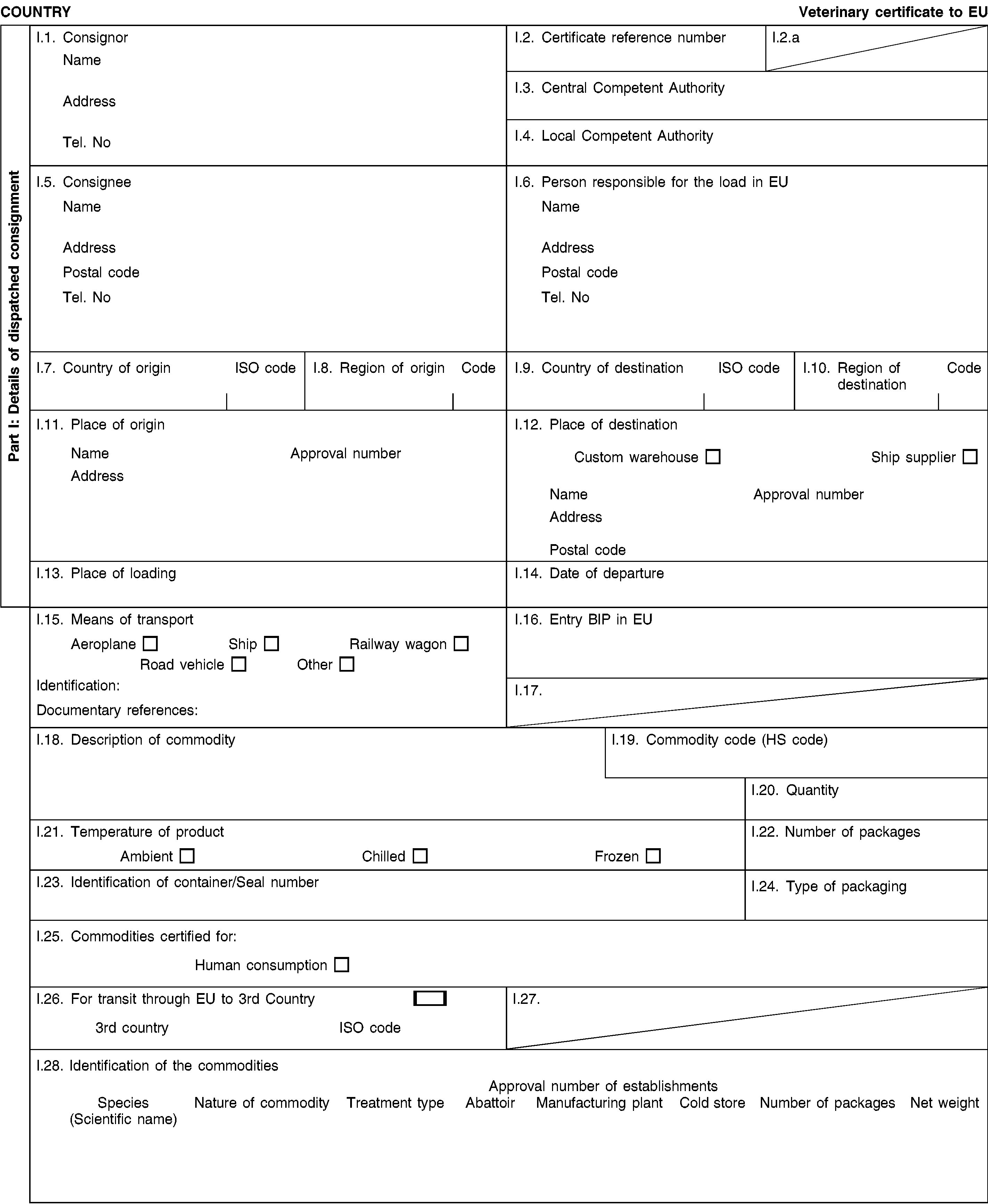

ANNEX XII
(as referred to in Article 20)
CORRELATION TABLE
|
This Regulation |
Decision 2006/696/EC |
Decision 94/438/EC |
Decision 93/342/EEC |
|
Article 1(1) first subparagraph |
Article 1 first subparagraph |
|
|
|
Article 1(1) second subparagraph |
Article 5 |
|
|
|
Article 1(2) |
Article 1 second subparagraph |
|
|
|
Article 1(3) |
Annex I and II (part1) |
|
|
|
Article 2 (1-5) |
Article 2 (a-e) |
|
|
|
Article 2 (6) |
Article 2 (m) |
|
|
|
Article 2 (7) |
Article 2 (j) |
|
|
|
Article 2 (8) |
Article 2 (k) |
|
|
|
Article 2 (9) |
Article 2 (l) |
|
|
|
Article 2 (10) |
|
|
|
|
Article 2 (11) |
|
|
|
|
Article 2 (12) (a-c) |
Article 2 (g) |
|
|
|
Article 2 (12) (d) |
|
|
|
|
Article 2 (13) |
Article 2 (h) |
|
|
|
Article 2 (14) |
Article 2 (f) |
|
|
|
Article 2 (15) |
|
|
|
|
Article 2 (16) |
|
|
|
|
Article 2 (17) |
|
|
|
|
Article 2 (18) |
|
|
|
|
Article 2 (19) |
|
|
|
|
Article 2 (20) |
|
|
|
|
Article 3 |
Article 5 |
|
|
|
Article 4 first subparagraph |
Article 5 and 3 |
|
|
|
Article 4 second subparagraph |
Annex I part 3 |
|
|
|
Article 4 third subparagraph |
Article 3 second subparagraph |
|
|
|
Article 5 |
Article 4 |
|
|
|
Article 6 |
|
|
|
|
Article 7 (a) |
|
|
Article 2 (h) |
|
Article 7 (b) |
|
|
Article 2 (g) |
|
Article 7 (c) |
|
|
Article 2 (i) |
|
Article 8 |
|
|
|
|
Article 9 |
|
|
|
|
Article 10 |
|
|
|
|
Article 11 |
|
|
|
|
Article 12 |
|
Article 4 (1) (2) |
Article 4 (1) (2) |
|
Article 13 |
|
Article 4 (3) |
Article 4 (4) |
|
Article 14 (1) (a) |
Article 9 |
|
|
|
Article 14 (1) (b) |
Article 11 |
|
|
|
Article 14 (2) |
|
|
|
|
Article 15 |
Article 18 |
|
|
|
Article 16 |
Article 8 |
|
|
|
Article 17 |
Article 16 (2) |
|
|
|
Article 18 (1) |
|
|
|
|
Article 18 (2) |
Article 19 (b) |
|
|
|
Article 18 (3) |
Article 19 |
|
|
|
Article 19 |
Article 20 |
|
|
|
Article 20 |
|
|
|
|
Article 21 |
|
|
|
|
Article 22 |
|
|
|
|
Annex I |
Annex I and II |
|
|
|
Annex II |
Annex I part 3 |
|
|
|
Annex III (I) (1-6) |
Annex I part 4 (A) |
|
|
|
Annex III (I) (7) |
|
|
|
|
Annex III (II), (III) |
Annex I part 4 (B) |
|
|
|
Annex IV |
|
|
|
|
Annex V |
|
|
|
|
Annex VI |
|
|
Annex B |
|
Annex VII (I) |
Article 7 |
|
|
|
Annex VII (II) |
|
Annex |
|
|
Annex VIII (I) |
Article 9 |
|
|
|
Annex VIII (II) |
Article 10 |
|
|
|
Annex IX (I) |
Article 11 |
|
|
|
Annex IX (II) |
Article 12 |
|
|
|
Annex IX (III) |
Article 13 |
|
|
|
Annex IX (IV) |
Article 14 |
|
|
|
Annex X |
Annex V |
|
|
|
Annex XI |
Annex IV |
|
|
|
Annex XII |
|
|
|
( 1 ) http://www.edqm.eu (latest edition).
( 2 ) Veterinary Laboratories Agency, New Haw, Weybridge, Surrey KT 153NB, United Kingdom.
( 3 ) http://www.oie.int/eng/normes/mcode/en_sommaire.htm
( 4 ) OJ L 296, 12.11.2009, p. 1.
( 5 ) OJ L 21, 28.1.2004, p. 11.
( 6 ) OJ L 237, 31.8.2006, p. 1.
( 7 ) http://www.oie.int/eng/normes/mmanual/A_summry.htm
( 8 ) OJ L 260, 5.9.1992, p. 1. Directive as last amended by Directive 2006/104/EC (OJ L 363, 20.12.2006, p. 352).
( 9 ) OJ L 188, 8.7.1992, p. 34.
( 10 ) Please give as much detailed information as necessary to allow proper assessment of the programme.
( 11 ) Please give as much detailed information as necessary to allow proper assessment of the programme.
( 12 ) OJ L 343, 22.12.2009, p. 74.
